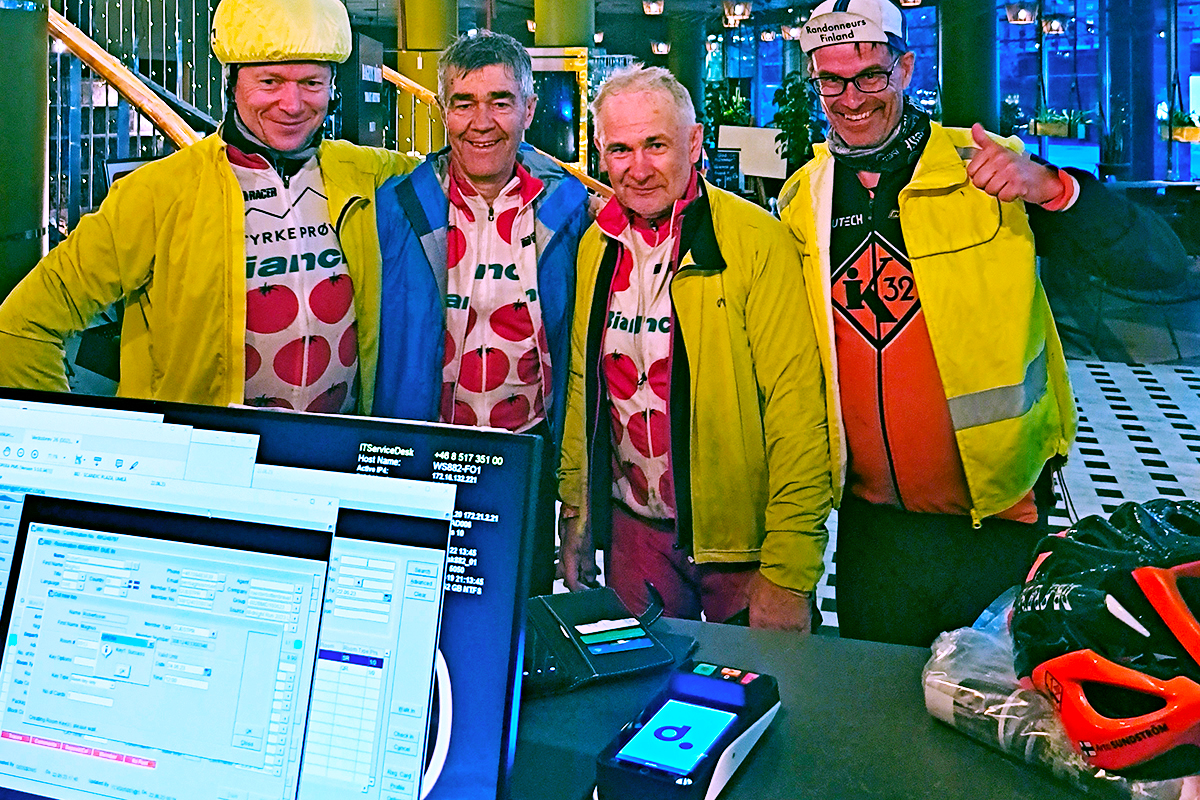Between the 19th and 23rd of June 2023, the cycling club Cykelintresset hosted the second edition of Midnight Sun Randonnée. This page contains written reports, photos and videos from cyclists who participated in the event.
Featured reports
Gerhard Kohl
Florian Kynman
Arto Sundström
Social Media
Tobias Janke
Mikaela Lindfors
Hugh Spear
Olaf Storbeck
Misc.
Photos & Videos
Gerhard Kohl
MSR – an unforgettable adventure on the bike
The idea
My plan to participate in Paris Brest Paris Brevet for the second time was thrown overboard by a suggestion from my randonneur buddy Olaf of the Brevet self-help group Frankfurt in the spring of 2023. He proposed to participate in the Midnight Sun Randonnée 1200 in Scandinavia instead. Let’s ride to the Arctic Circle, he suggested. A quick look at the website with its epic pictures convinced me immediately. Soon after, Peter Z. and Peter S. from the Brevet self-help group Frankfurt joined our plan.
My actual season highlight in 2023 was the Mittelgebirge Classique, on which I had focused 99% of my preparation. Given the supposedly ”easy” conditions of the Midnight Sun Randonnée, with 1,200 km and less than 10,000 meters of elevation gain, I wasn’t expecting much of a challenge. I was more concerned that there would only be three weeks between the Mittelgebirge Classique and the Midnight Sun Randonnée, and I might not have enough time to recover.
The weather in the Arctic Circle could be a problem, but favorable weather forecasts gave hope. We had planned two overnights in Hattfjelldal after about 450 km and in Jäkkvik after about 780 km, but at the latter without food facilities. If necessary, I wanted to get some sleep at the last control about 160km before the finish.
Getting there
The journey and its planning turned out to be turbulent. Originally, we planned to travel by train, but due to track construction works in Sweden, no tickets could be booked early. We therefore wanted to switch to a flight about 2 months before the brevet. However, when the codeshare flight of Lufthansa with SAS was canceled without giving any reason, Olaf was suddenly without a flight, because there was supposedly no more space for his bike case. Olaf finally decided to travel by car together with colleagues Peter and Peter. It would take them two full days to drive from Mainz to Umeå.
In the night, about 5 hours before I wanted to leave for the airport, it suddenly became exciting. SAS cancelled the Stockholm-Umeå flight completely via SMS, and after an hour automatically rebooked me on a flight that would not let me arrive until a day later, on race day itself. Unfortunately, SAS was not available by phone over the weekend.
Eventually, Lufthansa was able to rebook me on another connection that was scheduled to arrive shortly before midnight on the original day of travel. Only at the airport in Frankfurt I then finally learned that my bike case can actually be taken to Umeå. Finally I started believing that I will make it in time to the start line. And on Monday morning I finally met my fellow cyclists at the hotel for breakfast.

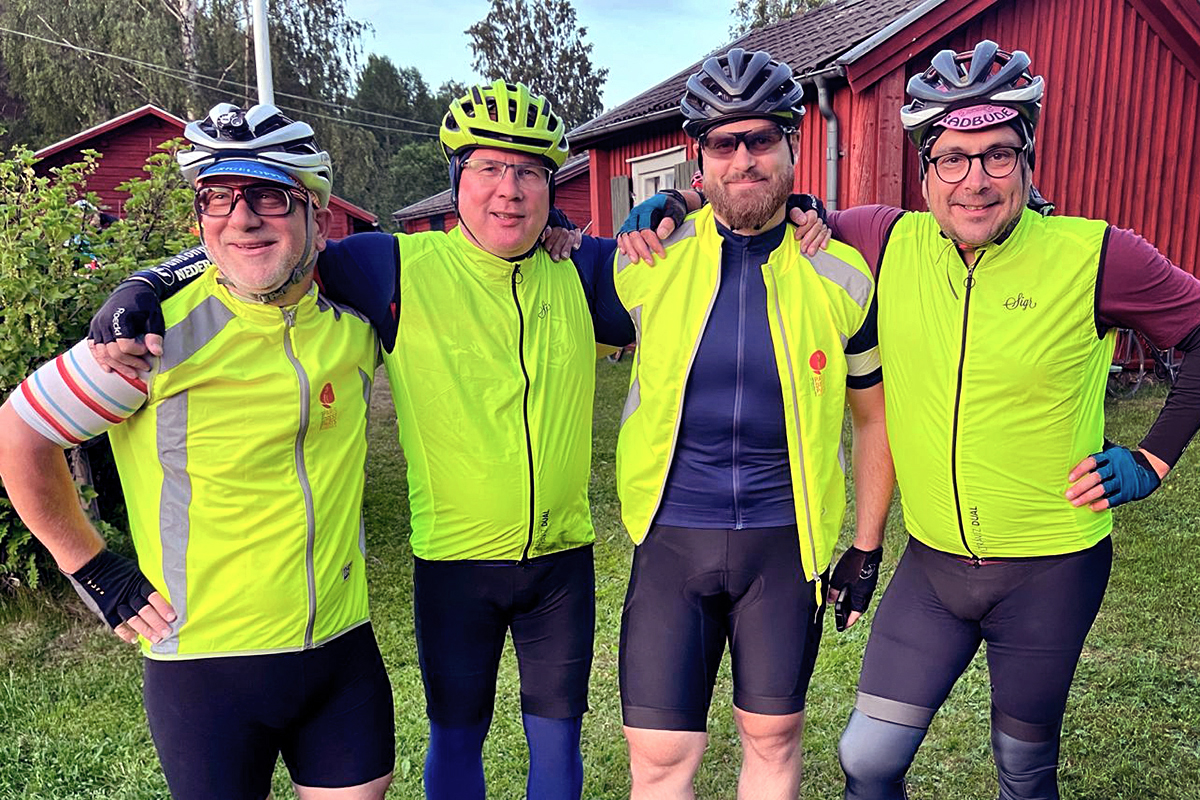
The start
The start of the brevet was set for Monday at 11:07 pm, the official sunset time. Even though the sun doesn’t really set so close to the Arctic Circle – just before the summer solstice.
Shortly after the late check-out in the early afternoon, still in the hotel, excitement spread, because due to construction work the first two stages were changed. Suddenly I was faced with the challenge of loading zipped GPX tracks onto my Wahoo via cell phone. I regretted not having practiced this before. However, I eventually got it done. The changes made the route longer, and it now totaled 1,226 kilometers.
Since the start was late in the evening, we had the whole day to kill time. We enjoyed a short afternoon snack at a homestead about 3 kilometers from the start, and then had dinner together in the evening. The start was about 10 kilometers west of Umeå. It was a good opportunity to get some strength back and make the final preparations.
During Monday it was very warm, but towards evening it surprisingly became relatively cool. We became a bit unsure if we should have packed an additional warm layer.
At 11:07 pm sharp, the time had come – the joint start towards the west took place. With a mixture of excitement and anticipation we started our journey on the endless roads of Scandinavia.
Day 1: Umeå – Hattfjelldal (465 km)
The brevet started in bright sunshine and clear sky just before midnight. It was very unusual that it never gets dark. The landscape was just like you imagine Sweden to be. Dense forests and lots of picturesque rivers, waterfalls and lakes, with occasional homesteads in between. The farther west we got, the rarer the resupply opportunities became.
In a fast group, we reached an average speed of around 30 km/h, which was unusual for me, and we completed the 200 kilometers in a gross time of not even 7:45 hours. My absolute record for a 200 km brevet course.

At kilometer 320 the announced gravel section began. Unexpectedly, however, the gravel was deeper than expected, which prompted some cursing from the ”divider” riders. My 42 mm tires handled well on the somewhat firmer car lanes, but when you had to swerve onto the shoulder due to overtaking cars, things got pretty wobbly and your pulse skyrocketed.
We also learned about a peculiarity of Swedish drivers. In the urban areas and on the larger interurban roads, the Swedes show a considerate driving style and overtook us with a large distance. If someone overtook us narrowly, it was without exception a German camper. However, on the long and monotonous connecting roads, especially on the gravel roads, the Swedes like to press on the gas to get ahead. That led again and again to rising pulse.
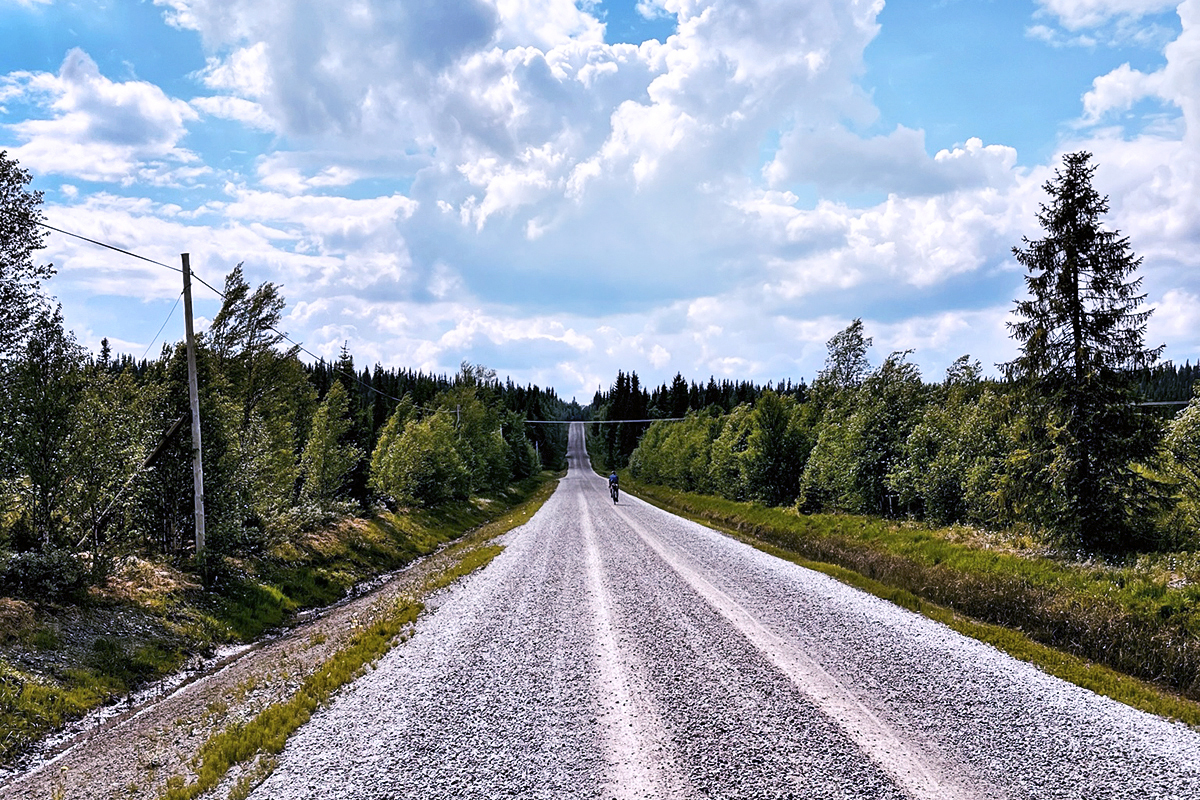
At the same time as the gravel section, the elevation gain began. The climbs became steeper, and the altitude factor of 5, now partly changed to 20 (=altitude meters per 100 km/1000).
After the control in Kittelfjäll at about kilometer 365 it began to rain harder and our hopes to get through dry were made to not. As usual, we delayed putting on our rain gear more and more. And suddenly we were soaking wet and had to continue with wet shoes and pants.
In the meantime, we had also learned which riders were basically riding the same gross speed as us. We kept running into these colleagues at the controls or on the side of the road, even if the driving speed itself was different. Our original team of four broke up into two teams of two right at the beginning of the day, due to slightly different gross speeds.
Annoyingly, I have found that my Wahoo navigation device can no longer be charged. This was already the second time despite IPX7 certification. First the Bolt V1, and now the V2. Fortunately, I had my old Bolt V1 with me as a backup device. However, charging was now only possible with very difficult plug positioning in complete silence. This meant that, navigation-wise, I was now just going from control to control, and the navi had to be recharged at each control. So it worked until we reached our destination, but it was annoying.
Then we reached the Norwegian border and suddenly the roads became a bit bumpier and narrower, and everything seemed somehow wildly romantic. A fellow driver explained to me that the signs at the border crossing meant ”the fairy tale road begins here”.
After about 23 hours we reached the control in Hattfjelldal, our planned first overnight stay. The room was very simple and unfortunately completely overheated, because the previous tenant had left the heater on in the bathroom. I didn’t have the nerve to change rooms since I had to use the little time to rest.
Day 2: Hattfjelldal – Jäkkvik (330 km)
Right at the beginning of the second day we started with a decent climb that took us into a kind of highland and reminded me of the Alps, but accompanied by drizzle. It was the appropriate atmosphere for this section.
Soon after, we came across the famous E6 – the famous dream road to the North Cape. However, as is often the case with such popular roads, everyone wants to drive on them. The E6 was therefore very busy by Norwegian standards, although it was still manageable compared to Germany. And the E6 should accompany us from now on about 150 km. Until shortly after the polar circle.
Finally we reached the North Sea, in the form of the long Ranfjord. The salty sea air was in our noses and gave the surroundings a special atmosphere.
After the checkpoint at Mo i Rana, we turned inland again and began the slowly ascending path to the Arctic Circle, which became steadily steeper. At the same time, the temperatures rose steadily, reaching an unexpected 30 degrees Celsius. There was no shade far and wide, but fortunately we were well on time and could slowly crank our way up.
Unfortunately, I had to realize in the meantime that I had forgotten my chamois cream at one of the previous controls. Now I had to do a good 600 km without it, and was now allowed to test how well I would manage without the usual chamois cream. And again shortly after, as I was filling up my water bottles, I noticed that I had also lost the measuring spoon for the dosage of my maltodextrin/isomaltulose powder. It seemed like some unfortunate circumstances had conspired against me.
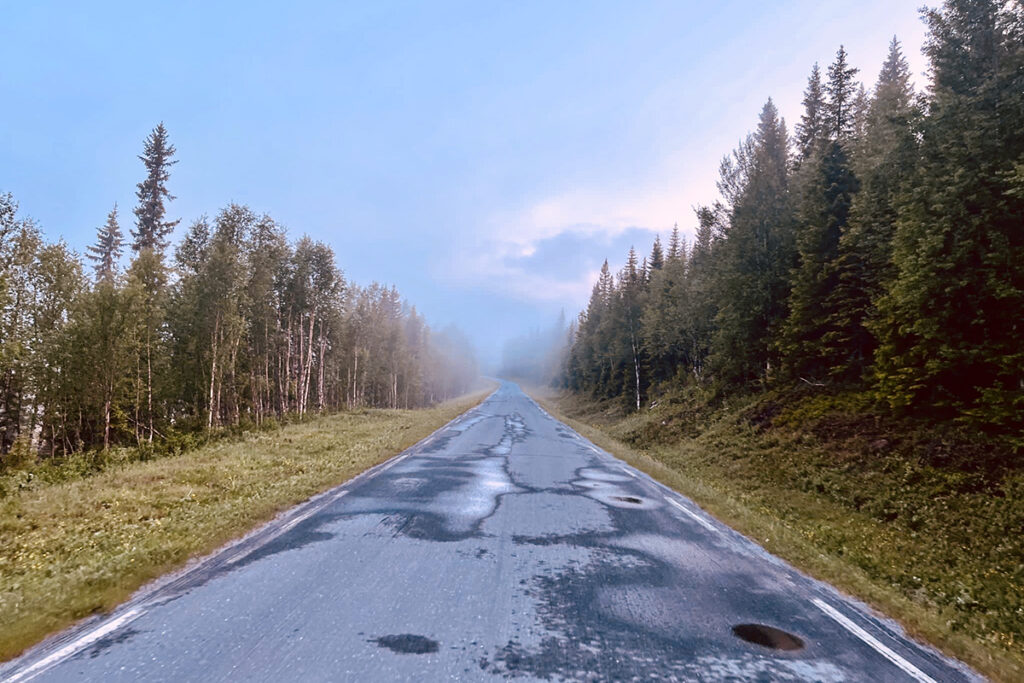
The charging problem of my wahoo, the lack of my seat cream and measuring spoon meant an additional mental burden the rest of the way. It was annoying, but should not deter me from reaching the finish in time.
On the way we discovered some kind of café inn where we could fortify ourselves with a coke, a piece of cake and an ice cream. The E6 was obviously a busy tourist area, which was reflected in the better supply situation.
After we had passed the control at the arctic circle, we could enjoy the hard-won altitude meters by a rapid descent. Unfortunately, on this descent I was suddenly overcome by a great fatigue, and I had problems keeping my eyes open. This was extremely dangerous, because even though we were going downhill at 60-70 km/h in places, trucks were still overtaking us.
Then we finally turned off the E6 and the next challenge awaited us in the form of a steep ramp in oppressive sun without shade. This effort cheered me up a bit, but during the following 600 meters of altitude I was still so tired that my fellow rider Peter Z. continued alone to the next checkpoint while I slowly struggled up the mountain.
The following plateau reminded me very much of Scotland. Simply beautiful, and the late afternoon sun bathed the landscape in a magical light.
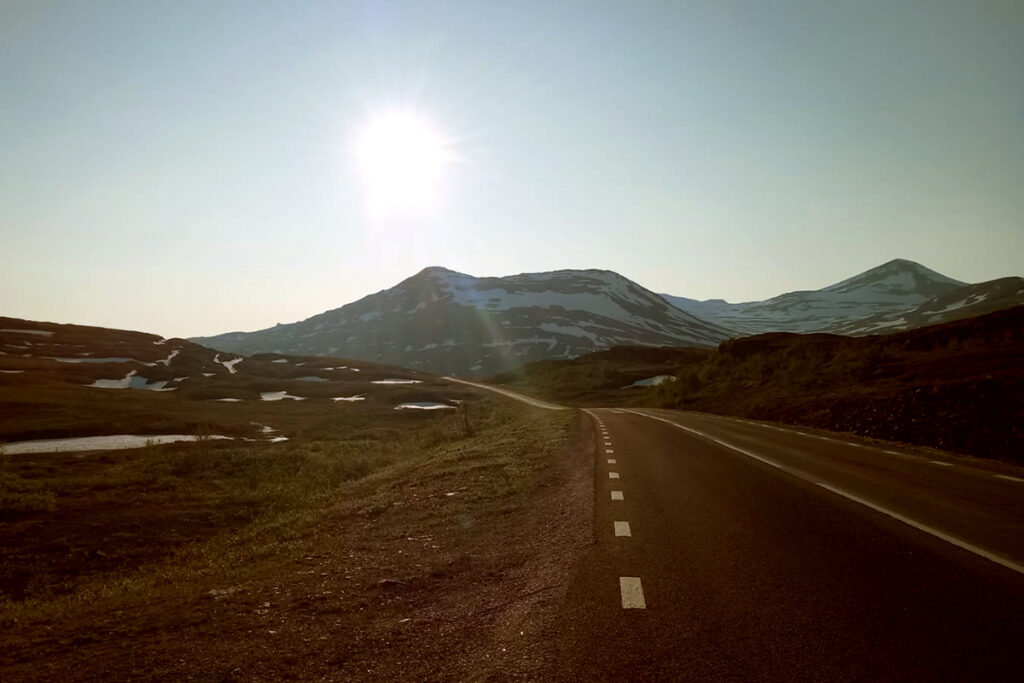
At the checkpoint at the campsite in Vuoggatjålme I met Peter Z. again, but we parted again, as I had booked my accommodation only another 40 km away in Jäkkvik, while he wanted to sleep a bit at the checkpoint.
Then in the middle of the night Olaf, who always followed us with some distance, joined me in the accommodation and we decided to continue together in the morning. This gave me a little more time to rest and recharge my batteries.
Day 3: Jäkkvik – Åmsele (309 km)
All four of us had arranged to meet near our cabin to continue our journey together. But somehow Peter Z. had missed our agreed meeting point and had driven too far. Nevertheless, I was able to catch up with Peter Z. after a few kilometers, and from then on we rode together again, while Olaf and Peter S. continued individually.
Rumour had it that if we made it to the checkpoint in Arjeplog before noon, we would be rewarded with a rich breakfast buffet. While those who arrived later would only get a wrap. Therefore, we rode as quickly as we could to the control and filled our bellies à la all you can eat.
Unfortunately, Peter Z. had not made it to the buffet in time. Whether that was the decisive reason, we don’t know, but he decided to stop at this control point and take the bus to Umeå.
Already on the way to Arjeplog, and even more so afterwards, it started to rain almost continuously. In between there were storm-like gusts with heavy precipitation that almost blew us off our bikes. Up to the last 100 km the rain should accompany us from now on, although mostly rather moderate.
Earlier I wanted to take part in the Length of Sweden Brevet. The LoS Brevet leads 2 200 km from the very north to the south of Sweden. Now I know that I will not ride this brevet. Sweden is very scenic, but riding all day relatively flat through forests and along lakes, and the only change is whether it rains or not – I can think of more attractive ways to bike.
And then finally came the long-awaited secret control. And what a surprise! There was a camp fire serving hot dogs, homemade cinnamon buns and a banana. And the rain had just let up a bit. The mood was on the upswing.
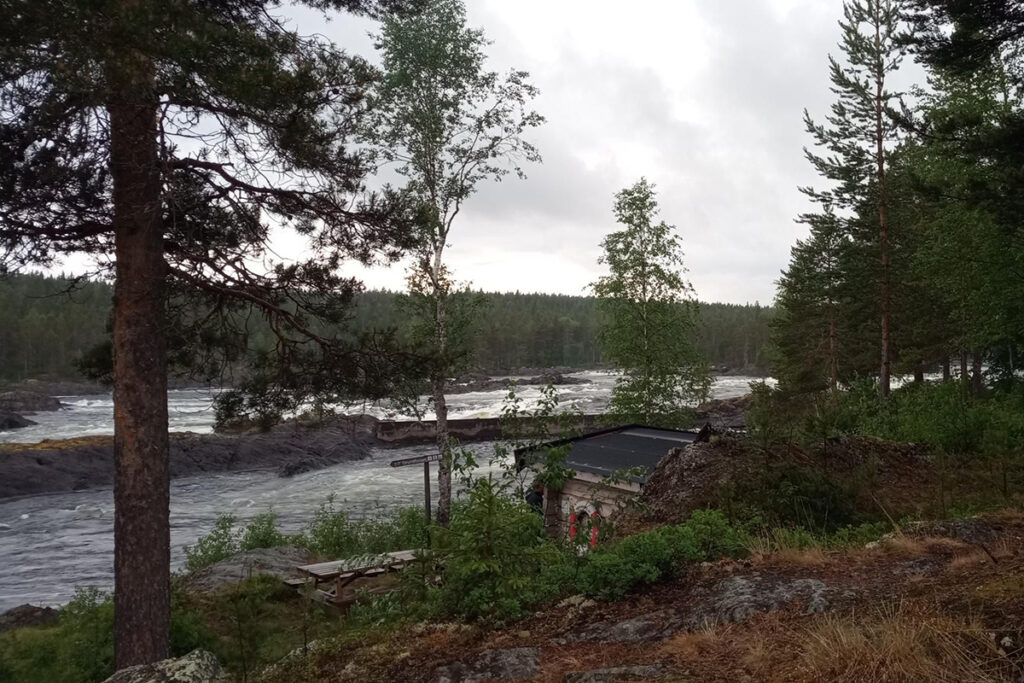
In the meantime, we were allowed to experience several times that we were on the road with a not so small group of equally fast randonneurs, and therefore it is always tight at the controls as far as sleeping places are concerned. Maybe that was the reason why I got involved in a small race with a group of three Spanish road cyclists and I was pleased to find that I could still show a little more substance in the last kilometers to outrun them a bit. However, the Spanish colleagues proved to be very smart, and did not stop first with the food, but first took care of a place to sleep – the last.
At first we were a bit disappointed, but then we learned that there were two more rooms. Although the beds were not made up, we had the room all to ourselves, including our bikes. That was fine.
Day 4: Åmsele – Umeå (120 km)
The next morning we had a surprise. Frederik, a Belgian who has lived in Sweden for many years and whom we had met on the very first day, suddenly stepped out of a hut and joined us for morning coffee.
Frederik is a very good and somewhat faster rider than we are, so we kept losing sight of him. He had already slept for four hours at the second control when we continued. In addition, he had left his cell phone on the road just before the Arctic Circle Centre and waited for it for over 2,5 hours. Nevertheless, he was able to catch up with us again.
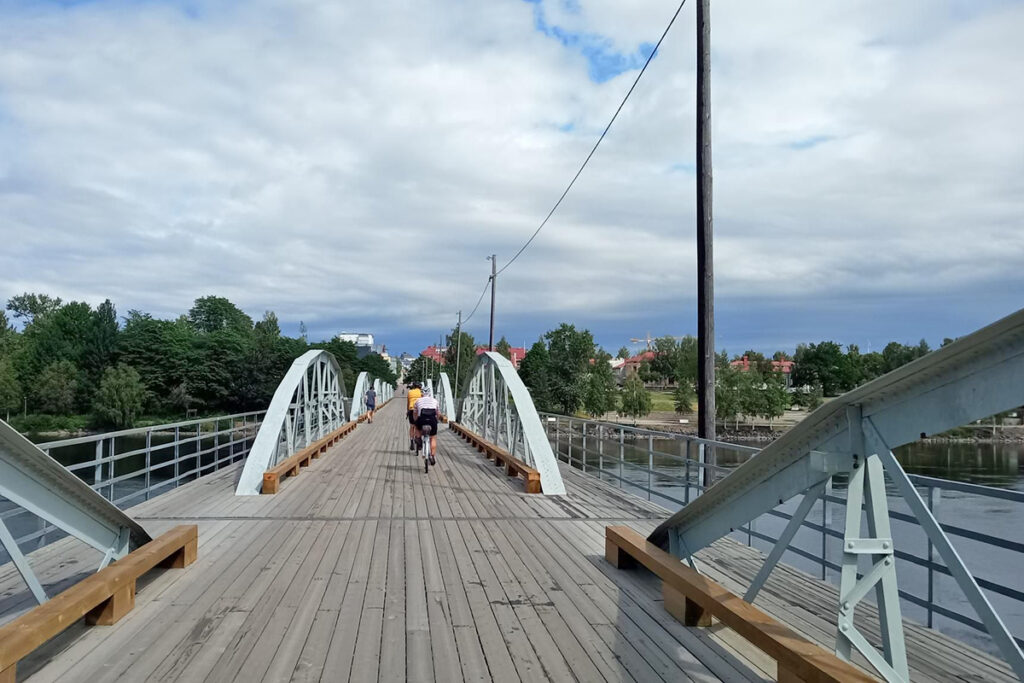
Spontaneously we decided to ride the remaining 120 km together. We arrived in Vindeln at 8 o’clock just as the supermarkets opened and could buy freshly baked cinnamon buns for our second breakfast.
As usual, the last kilometers dragged on a bit, but when we could already smell the sea, we knew that it would only be a few more kilometers. And then finally we were allowed to cross the river Umeälven for the last time to reach the center of Umeå and the Scandic Plaza Hotel, our destination. An unexpected construction site gave us another small detour, but then we could happily pick up our last control stamp.
Resumé
The MSR 1200 was harder for me personally than I expected, but that was more due to my focus in mental preparation than the brevet itself.
As for the weather, it’s fair to say that we were lucky for a trip to the Arctic Circle. The previous year there was snow in places, but we were spared that and instead had to deal more with the heat.
Scenically, it was a single dream, even if Sweden sometimes dragged on a bit. The effort to get there and back should not be underestimated.
Let’s see, maybe I’ll come back again …

Florian Kynman
One of the signs that summer has arrived to Scandinavia are the many road works. Some are planned long term maintenance, others unplanned and a consequence of the spring thaw. From a cycling event organisers point of view, road works are a continuous uncertainty factor.
At first, the only major road works in this years edition of MSR was maintenance work on a bridge three kilometres from the start location. But on the morning of the event I was informed that road work on the E12 scheduled to begin on the 19th of June had already started on the week before and had also been ongoing throughout the weekend. During this time 35 km of the E12 had been covered with a thick layer of chipseal. With an excessive amount of loose gravel expected on the road I decided to make a detour round the road works, for the safety of the riders as not all randonneurs are gravel specialists. This would however add 13 kilometres to the MSR course. In the afternoon, all preparations were finalised for the detour. New gpx-files for the detour were created and information emailed to participants. The checkpoint in Granö was relocated to the village of Vindeln.
Compared to MSR 2022, the weather during MSR 2023 was ideal. With the exception of a few thunder clouds round Hattfjelldal in Norway and windy conditions on the Vindel River stages to Umeå which brought some heavy rain showers, I couldn’t have asked for better weather for the event.
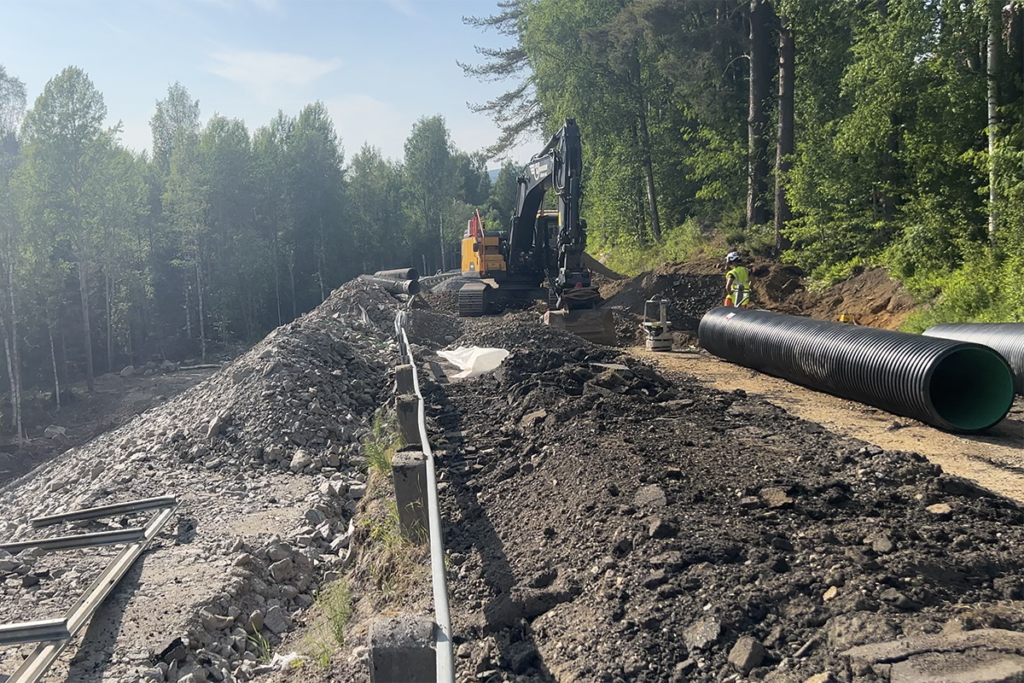
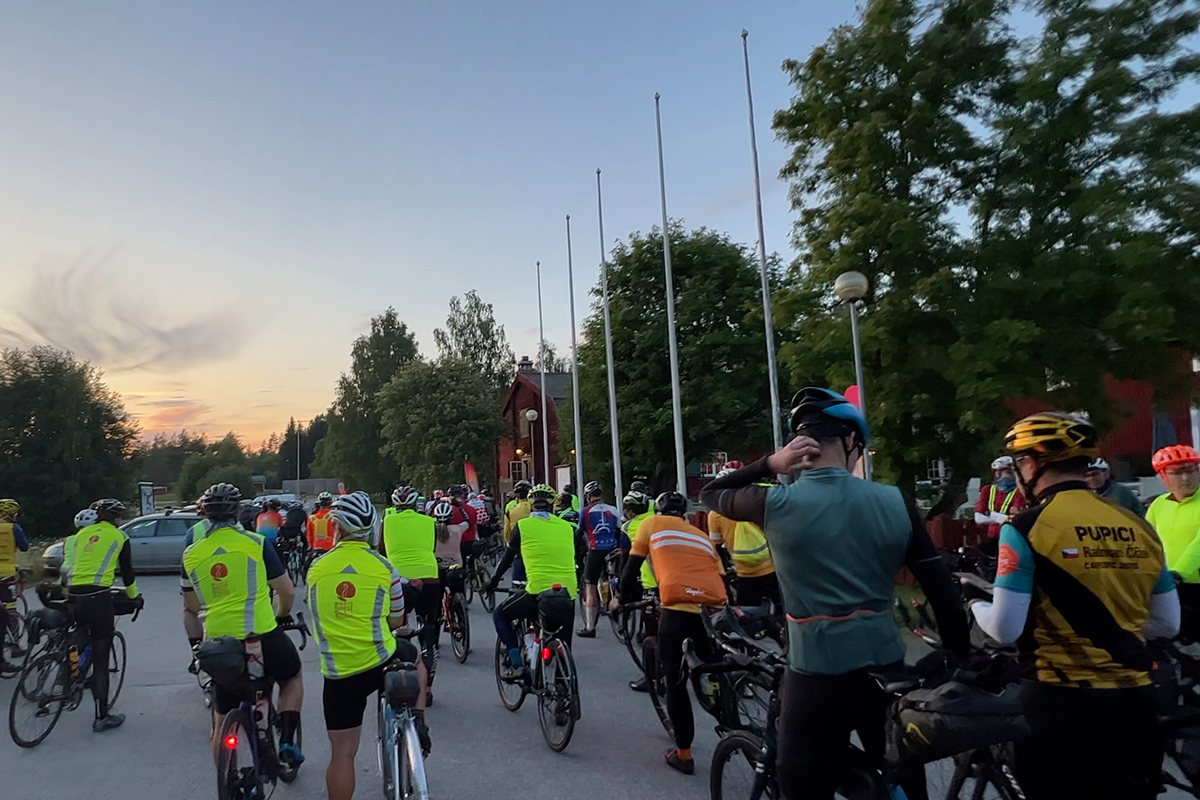
Umeå – Vindeln
After a hot day at Baggböle Manor and a buffet dinner in the evening we left Brännland Inn at sunset to the tunes of a saxophone riff played by Michael: a fellow cyclist, chef and proprietor of Brännland Inn.
On the first stage I stayed in the peloton until about ten kilometres from Vindeln when a couple of Czech riders whizzed past us. They seemed to be in a hurry to catch up with the groups who’d split away from the peloton immediately after start so I decided to follow them. It turned out that they had been cycling in the first group but a puncture had forced them to stop after a few kilometres. We arrived to the improvised checkpoint in Vindeln together where we ate a chocolate ball with coffee.
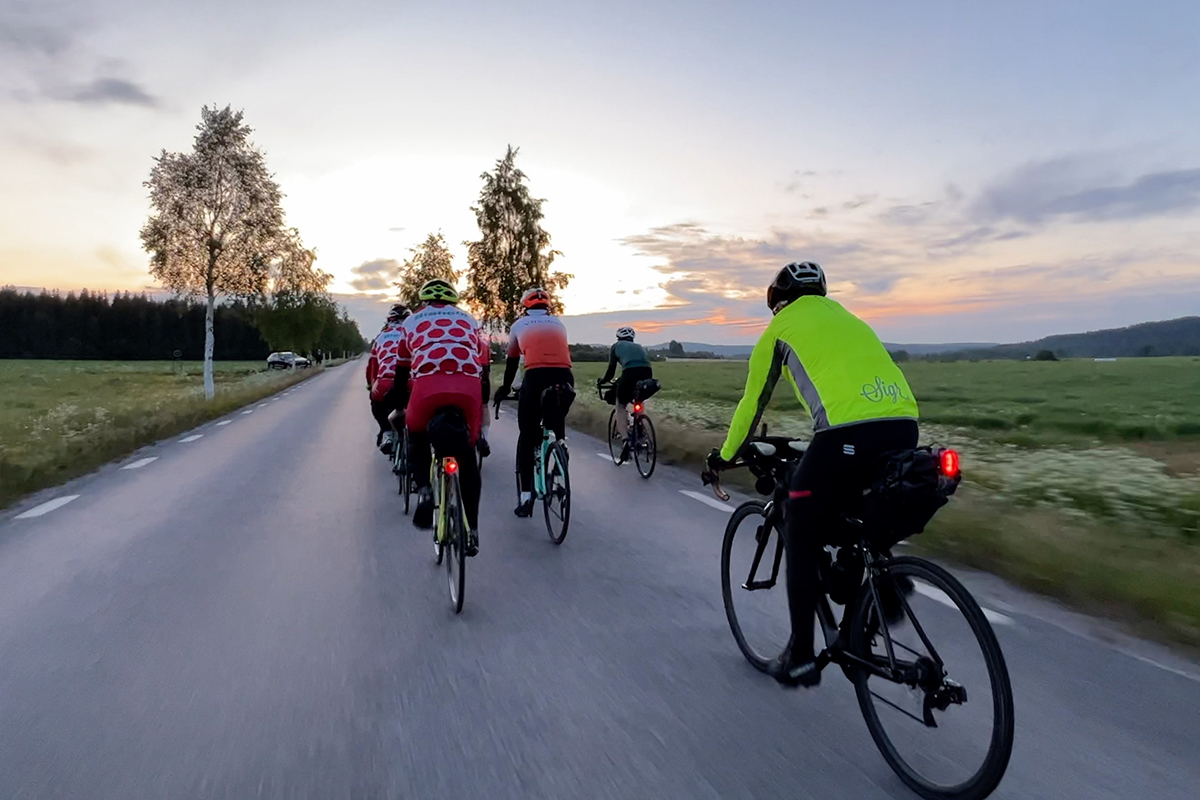
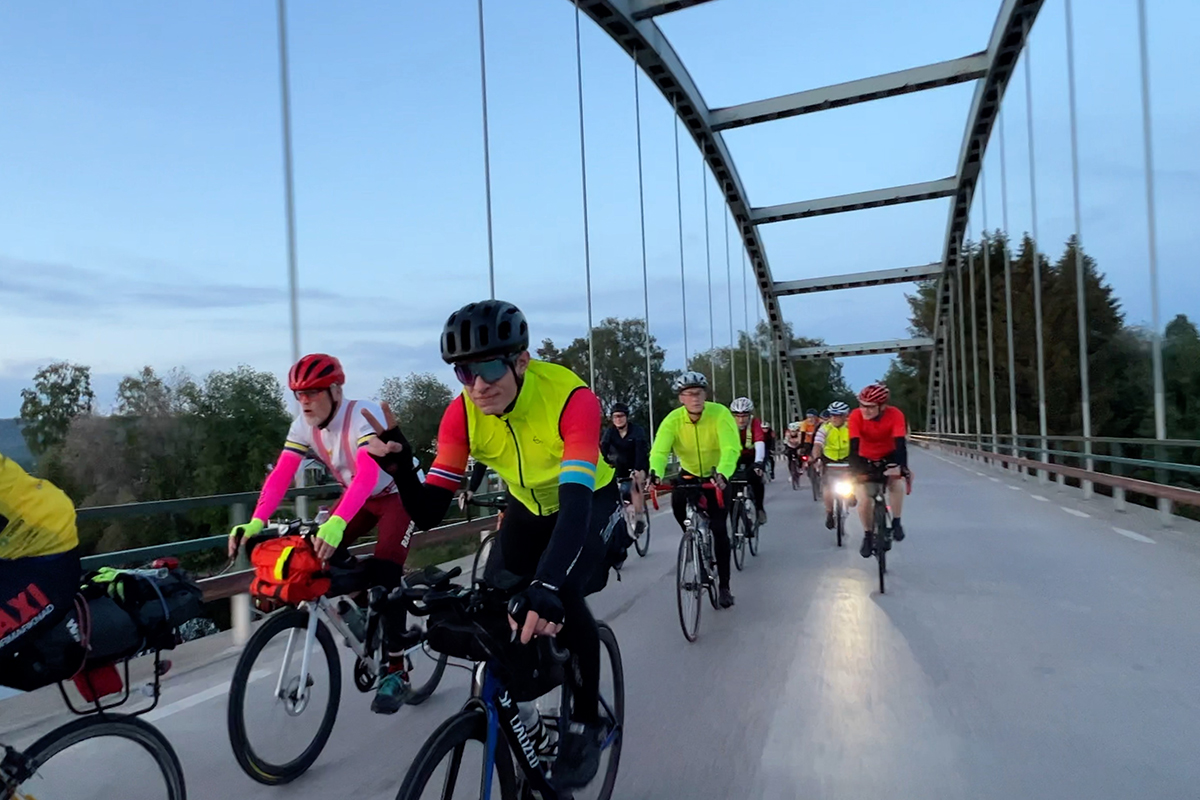
Vindeln – Lycksele
Stepan and Radovan, the Czech riders, stopped in Vindeln so I headed out alone on the next stage to Hotel Lapland in Lycksele. When leaving Vindeln I was however forced to stop at a level crossing to wait for a long timber train to pass. Waiting there Niklas, a cycling colleague from Umeå, caught up with me and we rode on together. Checking the average watts so far I realised that I hadn’t recharged my Assioma power meter pedals after doing the final qualifying brevet to PBP during the weekend before MSR. A BRM 600 so the batteries were sure to die at some point during the trip.
It was a calm night and we were making good speed when suddenly my bike started to make strange and unusual noises. After stopping a few times to check it over we determined that the sound was coming from the bottom bracket. If I peddled backwards before peddling forwards again the noise would stop. I didn’t know it at the time but this was the first sign of a failing crank bearing.
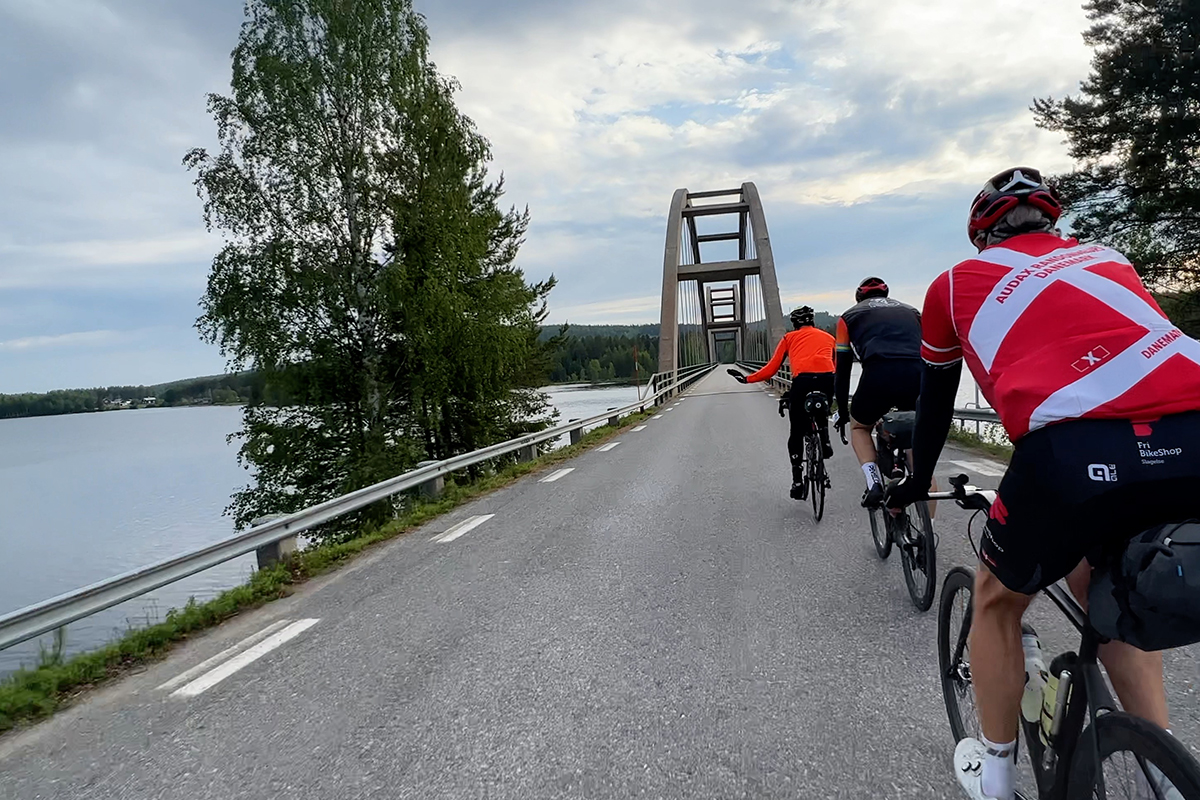
Lycksele – Storuman
Reaching Lycksele we caught up with one of the groups that had slit away from the peloton. Niklas stayed behind at the hotel so I headed on with this group towards the next checkpoint Storuman Camping. Cycling in a group on a mostly flat stage following the Ume River with hardly any wind made this the easiest stage of the course.
Storuman – Kittelfjäll
We arrived at Storuman in the morning and there I caught up with Vesa a Finnish cyclist who I’d ridden the next stage to Kittelfjäll with in 2022. After a quick meal we set off on this the first hilly stage of the course, keeping good speed all the way to the gravel section.
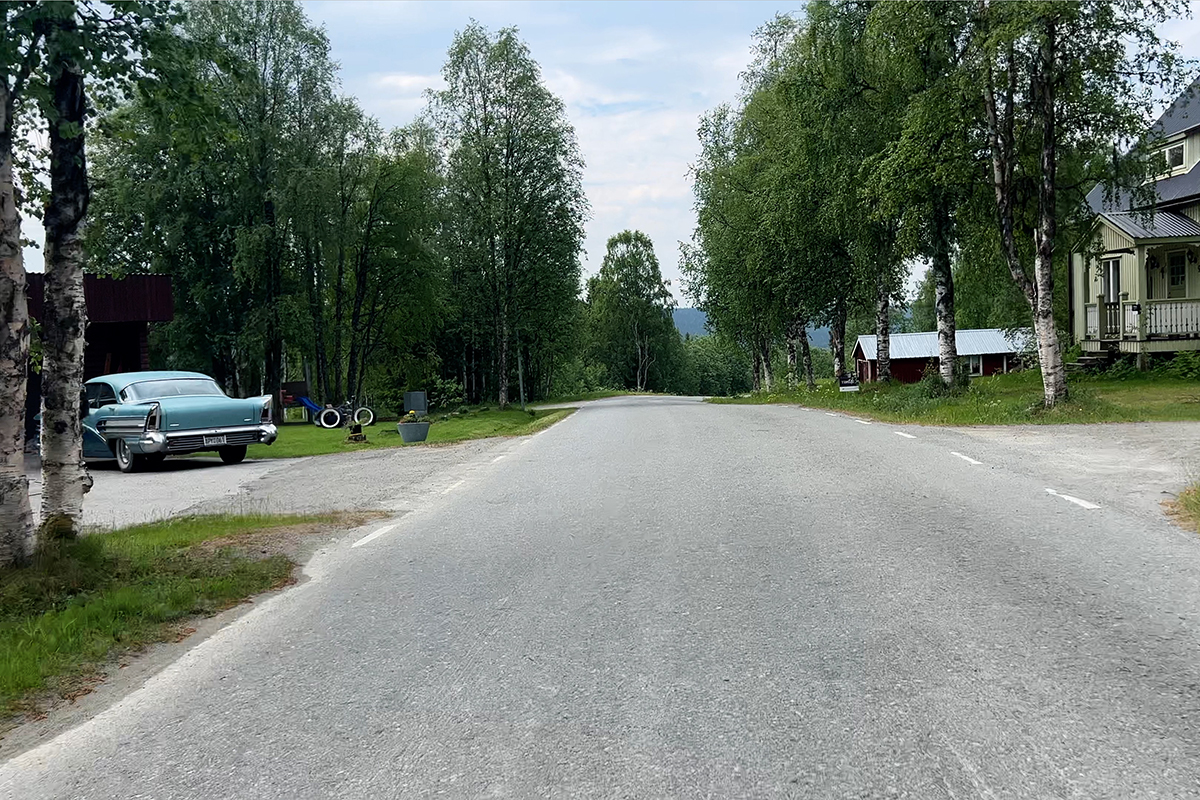
There had been some road maintenance of the gravel section this year so there was a lot of loose gravel on the road making for a wobbly ride if one didn’t stay in the wheel tracks from car traffic.
After a while I noticed that my Garmin mount had shaken loose so I had to stop. Luckily I didn’t lose the screw which held it in place but the Allen key on my multitool didn’t fit in between the aero bars in my bike so I continued on, holding on to the Garmin and battery pack with one hand so it wouldn’t drop down again. Reaching the next checkpoint Fjälltorget in Kittelfjäll I borrowed an Allen key and secured the mount on the handle bar again.
Kittelfjäll – Hattfjelldal
After a plate of freshly made spaghetti bolognese at the restaurant Fjälltorget, Vesa and I set off again on yet another challenging stage. This time on narrow and winding roads through undulating mountain terrain. The weather had been great up until now but as we approached Hattfjelldal dark clouds rolled in bringing thunder and heavy rain showers. First just a few drops but then all of a sudden it was pouring down. Before I had time to put my rain jacket on I was soaked through. But the rain was warm and it had been a hot day so I continued on the last kilometres to Hattfjelldal in my jersey.
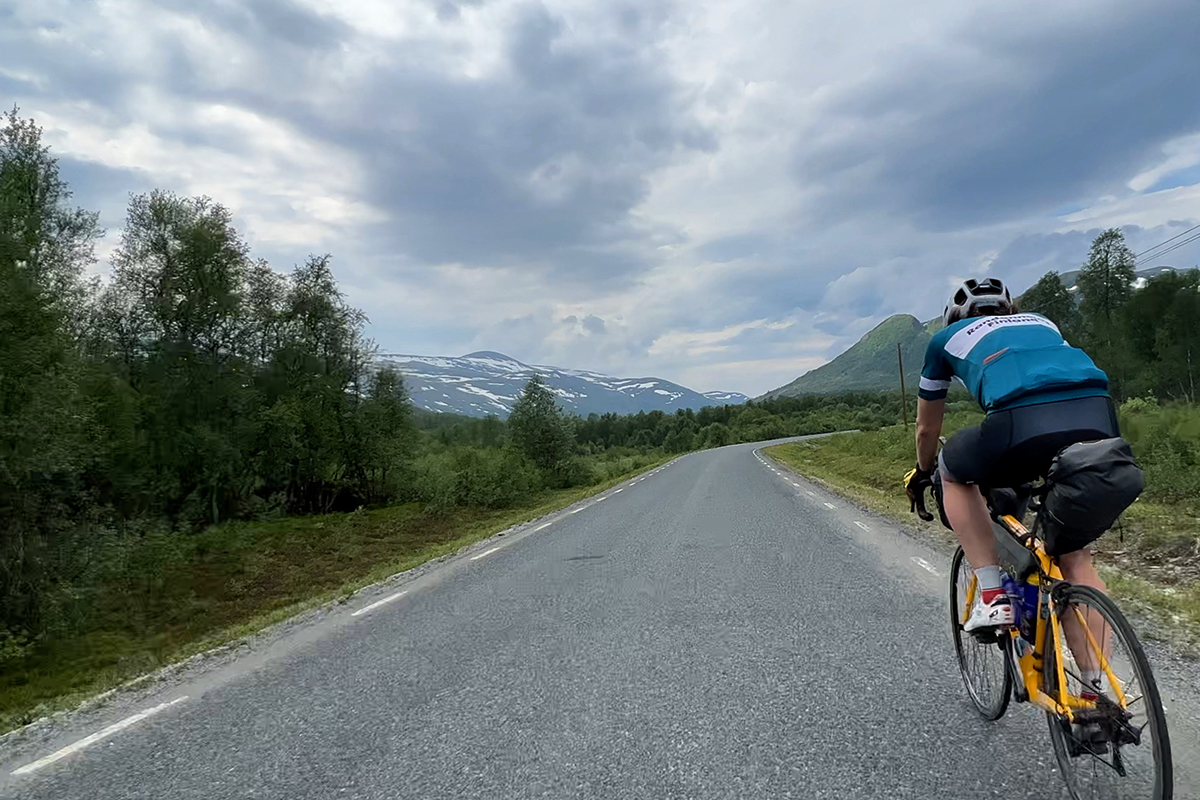
In the rain, on the steep climb up to the checkpoint Hattfjelldal Hotel my bike started to make noises again. But this time much worse than before with loud crunching and scraping sounds coming from the crankshaft. Reaching the hotel I checked the cranks and found that they would hardly turn if pushed by hand. Now was the time for the first hero in my story to step in.
Seeing my predicament, Even the hotel manager jumped in his car and sped off to buy a can of WB-40. When he came back, I held down the bike and Even forcefully pushed the cranks round whilst emptying the can of WD-40 into the bottom bracket. Doing this for a few minutes we managed to get the cranks turning reasonably smooth again.
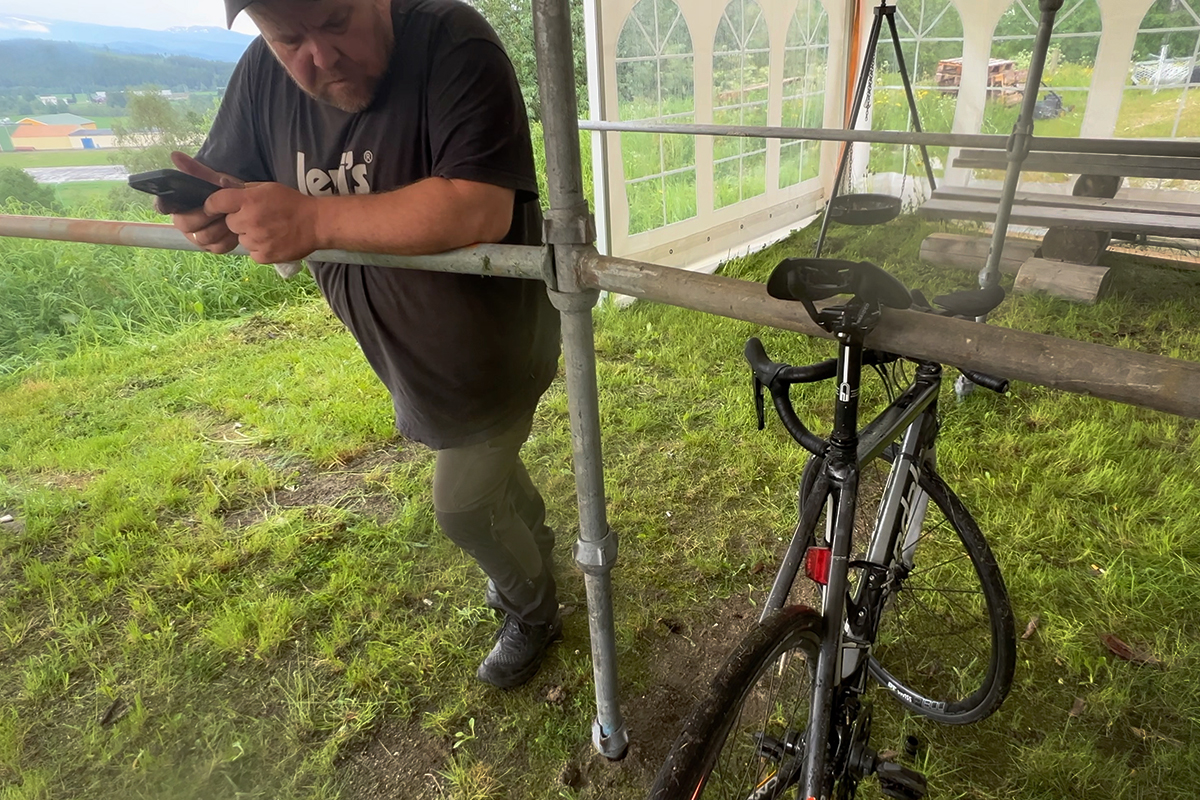
The rain would occasionally stop and in one of the interims Vesa left for Mo i Rana the next checkpoint whilst Even and I continued work on my bike. I would need special tools to remove the crank arms on my Cannondale in order to change the crank bearings and for that I needed a bike mechanic. Hattfjelldal had none so my best chance of fixing the bike was in Mo i Rana. Waiting for the rain showers to end I took a second helping of Even’s delicious arctic char soup with Focaccia bread.
Hattfjelldal – Mo i Rana
In the evening most of the weather front had passed so I left Hattfjelldal for Mo i Rana on yet another undulating stage round lake Røssvatnet. This stage starts with a steep and long climb, no more than a kilometre or so from Hattfjelldal. And here the crank bearing finally gave up completely, collapsed, disintegrated and the crankset started to tilt and wobble. There was no point in turning back and to DNF was out of the question so I pressed on.
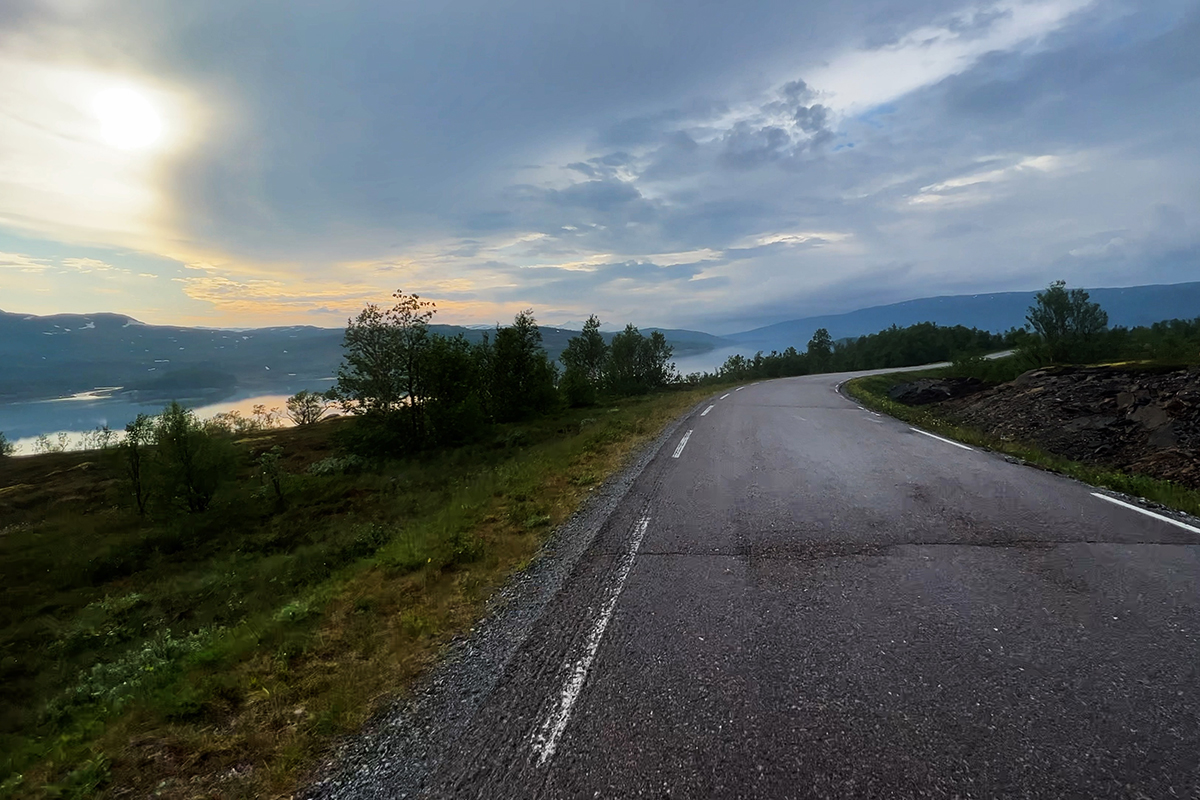
Because the chainring was now rotating at a slight angle to the cassette I had to stay in the smaller gear to prevent the chain from dropping off. Fortunately Tobias a German rider caught up with me. We made slow progress along the lake as every time I pushed harder on the peddles the bottom bracket would make excruciatingly painful noises as if something inside was about to break but we had a nice chat on the way and stopped to take photos from time to time.
Reaching the village of Korgen next to the Rana fjord we decided to take a break at a Circle K. They were closing at 22:00 so with eight minutes left we were quick to buy a soft ice cream each and a chocolate bar and to find a diner bar stool to sit on by a window. Looking out the window we saw the Austrian rider Gerd thunder by on the E6. He’d been in the lead from the start but made a wrong turn after Storuman.

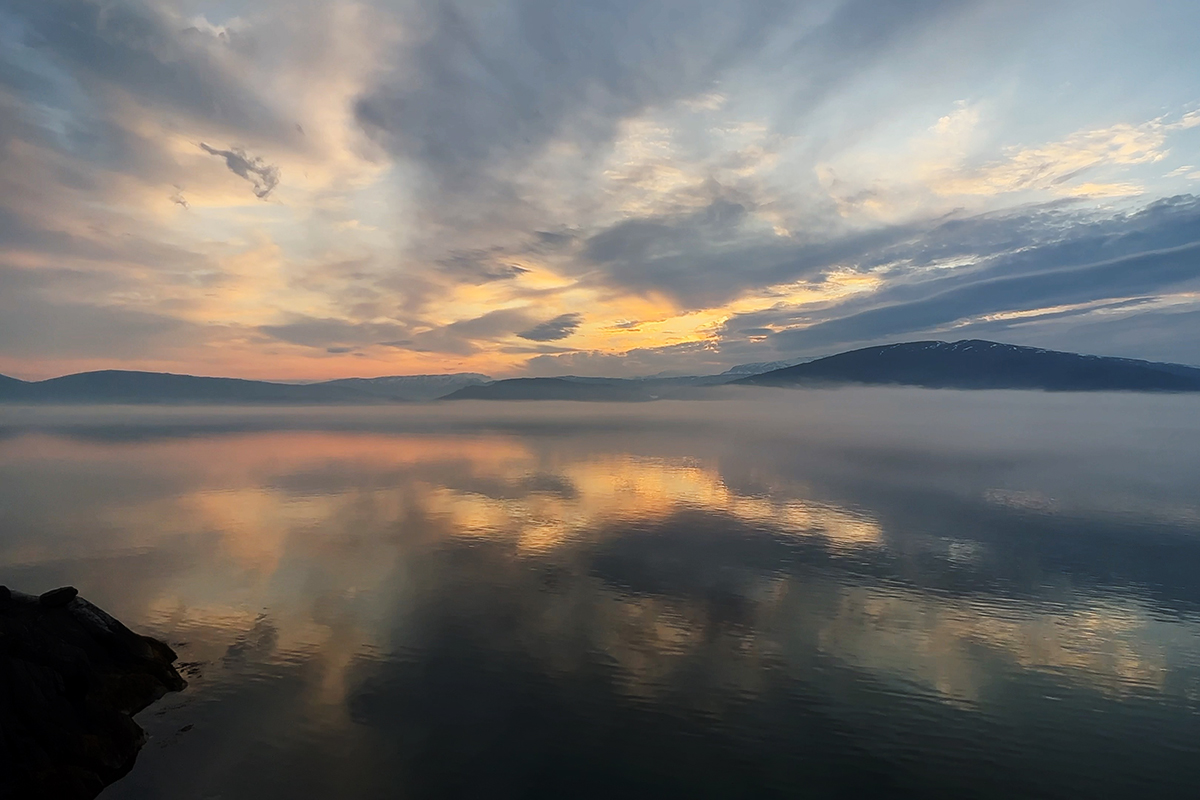
The Circle K closed and we ate the rest of our ice creams outdoors before heading onto the E6 ourselves. Here the traffic intensified. The E6 is the busiest stretch of road on the route. Not having to climb as much the pace picked up and we soon reached the Mo i Rana checkpoint where the next hero in my story was waiting: Bjørn-Einar from the local cycling club Rana Sykkelklubb.
Before I left Hattfjelldal Even had phoned Bjørn-Einar and described my mechanical issues. Bjørn-Einar had then found bearings that fit my bike and brought his tool box with him to Yttervik Camping where the checkpoint was located. We put my bike in a repair stand and set to work again. After going through Bjørn-Einars tools we still couldn’t remove the crank arms. There was nothing left to do but to wait for the bike shop Sport1 to open in the morning. Perhaps they had the special Cannondale tools? I walked around for most of the night chatting with riders and thinking about my options if the bike couldn’t be repaired. Could I perhaps rent a bike in Mo i Rana?
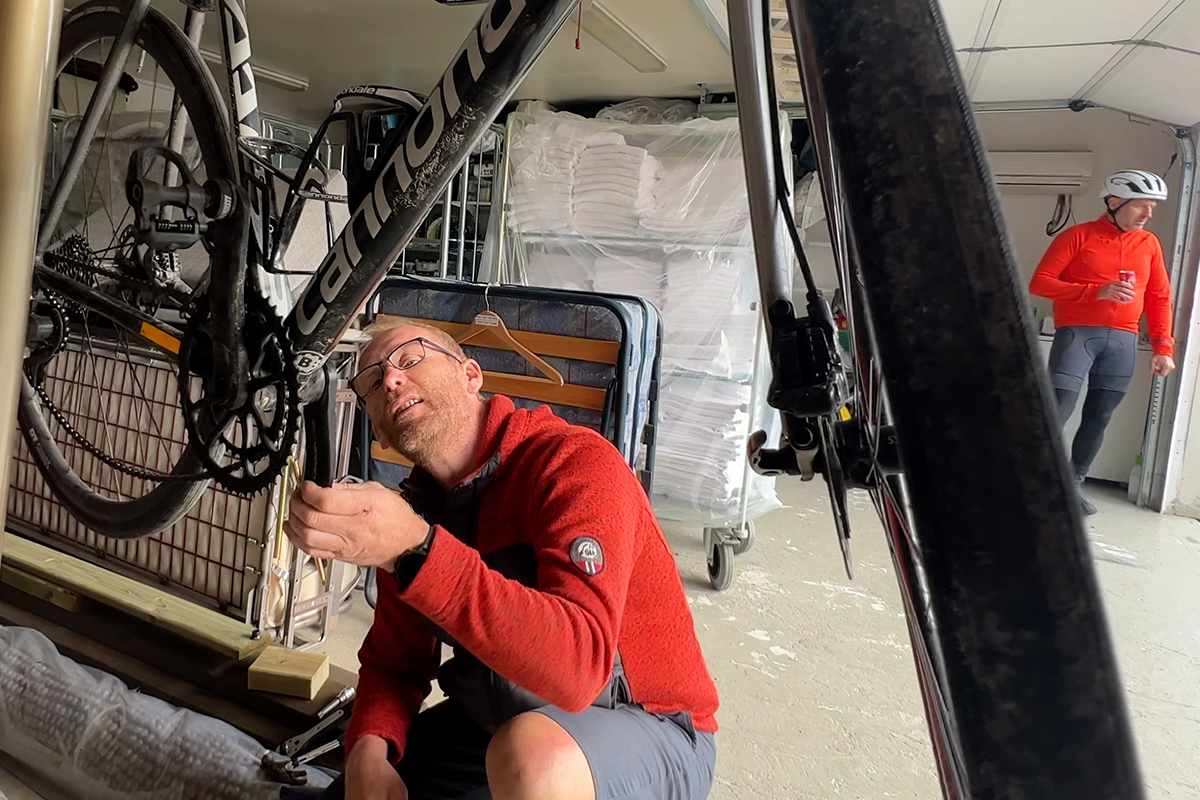
In the morning Bjørn-Einar made a phone call to the bike shop and arranged so that I could borrow his car to transport my bike to the bike shop in Mo i Rana where the bike mechanic at Sport1 Ole was waiting: the final hero of my story.
Unfortunately Ole didn’t have the special tools to remove the crank arms on a Cannondale Hollowgram crankset either. I phoned my mechanic in Umeå and asked if he could send a photo of the tool needed to remove the crank arms. After looking a the photo Ole walked back and forth between my bike and the tool draws in his workshop trying out different possibilities until he at last found a combination of standard and not so standard tools that worked! At last the crank arms could be removed!
Pieces of spacers, the bearing seal and bearing cage fell out of the bottom bracket when the crank arms were removed. The bearing beads were missing. Most likely they were scattered along the Røssvatnet road. The crank axel itself had a deep grove in it from being ground against the outer ring of the crank bearing on all the climbs between Hattfjelldal and Mo i Rana. Could a new bearing be press fitted into the bottom bracket and would it fit on the battered crank axel? To my relief it could but more special tools were needed to tighten the lockrings. With unrecoverable parts missing and no special Cannondale tool to tighten the lockrings to the required 47 Nm Ole tightened the cranks together as much as he dared. The repair was going to be temporary but it would most likely get me back to Umeå. Before leaving, Ole handed me an Allen key to tighten up the lockrings with just in case a crank arm came loose. I kept it in my back pocket for the rest of the ride. Asking to pay Ole simply shook his head and said: ”Just let them know about us”.
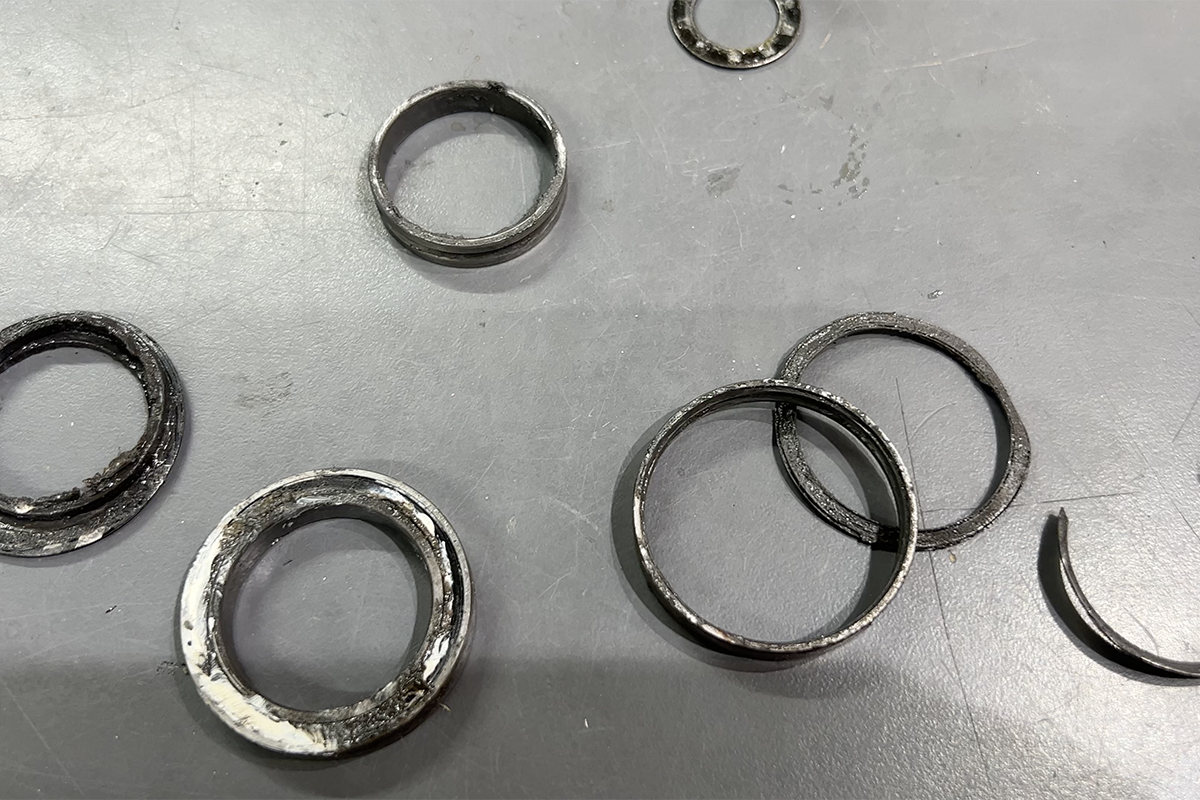

Mo i Rana – Arctic Circle Centre
Back at the Yttervik camping I assembled my bike and left the checkpoint around lunch time together with the last of the cyclists who arrived there with minutes left before it closed. The sky was clear and it was going to be a beautiful but hot day for the climb up to Saltfjellet and the Arctic Circle Centre. The bottom bracket would creak and crack as soon as the road steepened and I pushed harder on the peddles but the bike held together!
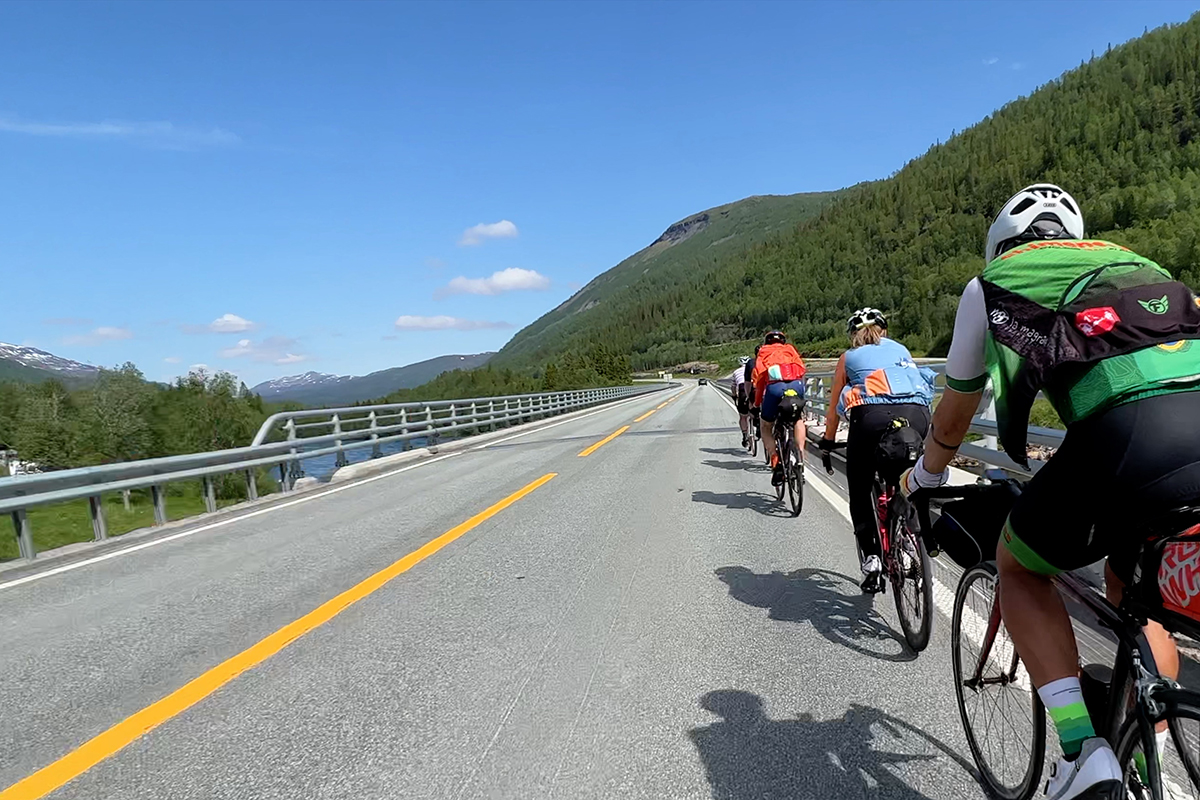
During the climb I received phone call from a British rider who arrived at Mo i Rana after the checkpoint had closed. There is no public transportation between Mo i Rana and the nearest village in Sweden so I made a brief stop to make arrangements for a taxi service to transport him and his bike to Hemavan in Sweden from where he could take a bus back to Umeå. Later on in the day two riders from Sweden also abandoned the brevet in Mo i Rana and joined him at the hotel where he was staying before for the trip back to Sweden the following day.
Arctic Circle Centre – Vuoggatjålme
Arriving at the centre I met Frederik who was waiting for his mobile phone to be delivered from the Arctic Circle Motorcycle Museum further down the road where he’d forgotten it. After a waffle with coffee, a soft ice cream and a wrap I then left the Arctic Circle Centre and was soon joined by Adrian and Christian, two riders from Germany. We made company to the Junkerdal climb where I again stopped briefly for some more event coordination and to create a Facebook post that showed the first batch of cakes specially designed for our event by our local French confectioner in Umeå. I gave them the name ”Soleil de Minuit” and the cakes would later be waiting for the riders when they arrived at Umeå Plaza.
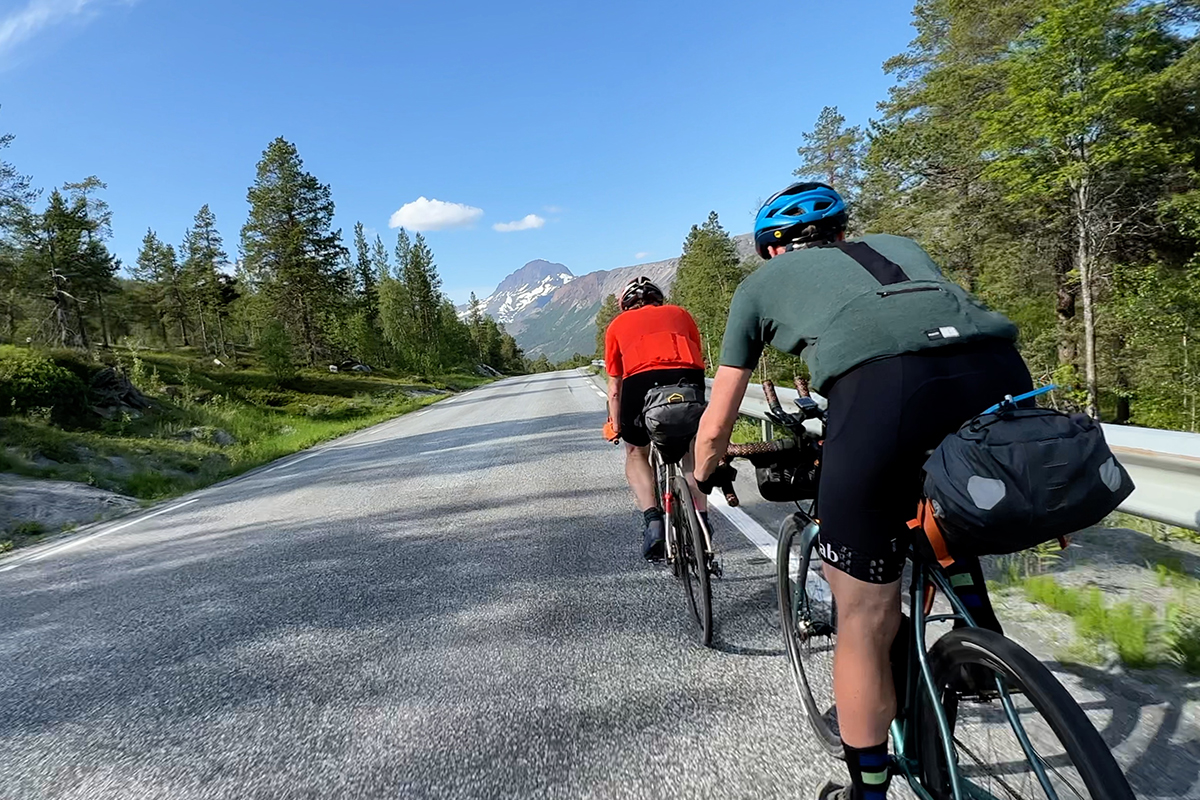
In light of last year’s weather, there was speculation about sauna facilities at the new checkpoint Vuoggatjålme before the event. But with temperatures up to +28°C on the climbs up Saltfjellet and Junkerdal, my main question became instead whether Vuoggatjålme could keep up with the orders for chilled drinks.
I reached the mirror-shiny lake Vuoggatjålme late in the evening but it was still hot and the sky was clear. The atmosphere in the restaurant at Camp Vuoggatjålme was relaxed and uplifted. Riders were drinking beer and conversing cheerfully. Most of the climbing was now behind us. From here on it would be downhill to Umeå and the coast of the Baltic sea.
Now having time to look through messages on my phone I discovered a message from a cycling colleague back home who was following the event via the live tracking page on our website: ”DNF? How are you doing? Has anything happened?” the message read.
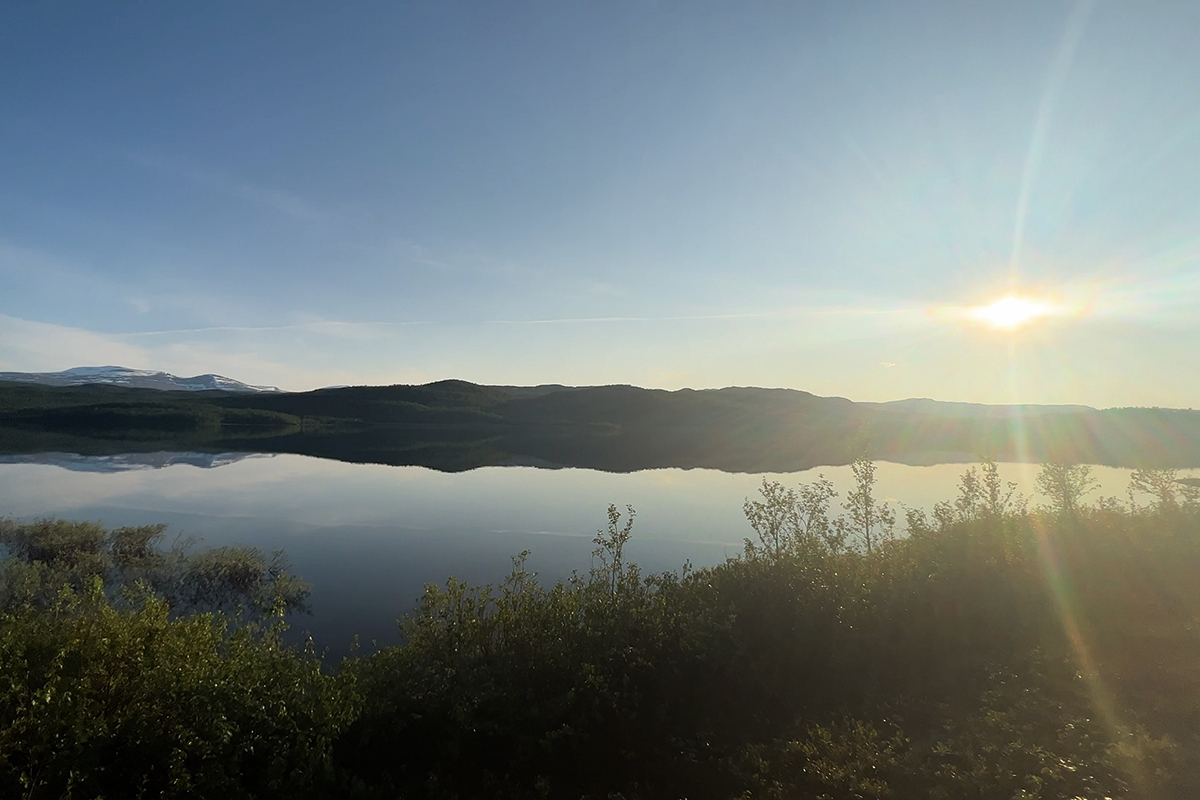
DNF?? I hadn’t DNF:ed what was going on?? Fortunately the events web app developer Bengt was also doing the ride and he also happened to be at the Vuoggatjålme checkpoint so I asked him. It turned out that one of the volunteers at a checkpoint was using an iPad and when he scrolled back and forth through the list of riders he’d occasionally accidentally press the DNF button next to a riders name. Clearly if we do MSR again the web app will need to be iPad-proofed. My DNF status was then swiftly changed and I was back in the event again.
One of the many enjoyments of being a cyclist is the taste of an ice cold beer after a long hot day on the bike. Before I left Vuoggatjålme I’d made time for two beers and bought a homemade blue berry energy bar to take with me which became yet another culinary pleasure waiting to for me on the ride.
Vuoggatjålme – Arjeplog
During the night, what seemed to be a mild tail wind turned into a head wind before I reached Arjeplog. The weather forecast had promised rain and the observed weather front now looked to be on its way.
Also at Hotel Hornavan the bar was open and riders were having a beer before heading off to their pre-booked hotel rooms. Checking to see if there was room for me in the sleeping quarters I discovered that Tomato Team, our large group of friends from across the Baltic Sea, had arrived to Arjeplog and were now occupiying most of the available air mattresses so I continued on to the next checkpoint Sorsele River Hotel.
Arjeplog – Sorsele
On the way to Sorsele I ran into a herd of reindeer on the road and also spotted one of many moose in the woods next to the road. Moose are generally more shy and they tend to be more cautious when crossing a road.
In 2022 the temperature at night on this stage was below zero, this year it was +16°C. Instead of a sauna or a nap I took a shower when I reached Sorsele River Hotel. The spa area also had a jacuzzi which was tempting but I felt I should press on to try to beat the rain.
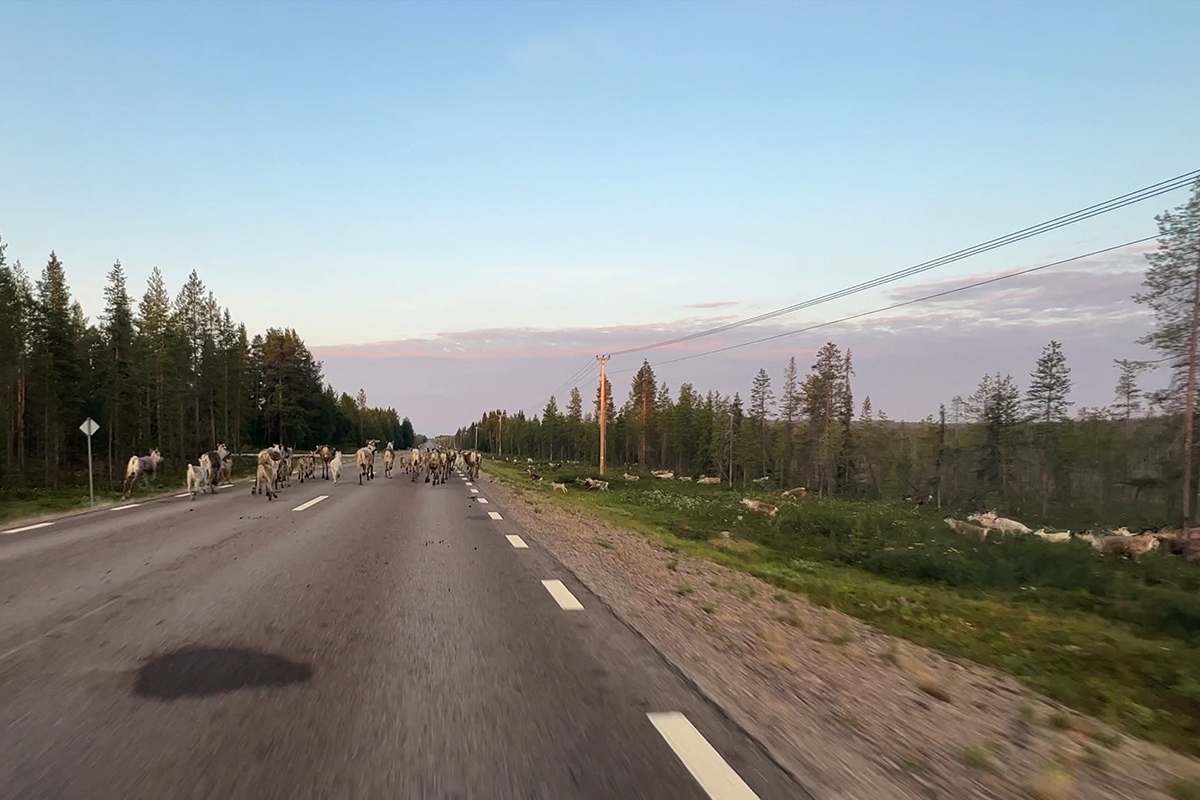
Sorsele – Åmsele
After a meal and a coffee I headed down to the final stages of the event along the Vindel River. The wind soon started to pick up and now it was only a matter of time before I would run into the first rain showers.
For the 2023 event I’d moved the secret checkpoint to the Vindel River. This to give riders an extra opportunity to their fill water bottles and to have a midway snack on the otherwise long stage between Sorsele and Åmsele.
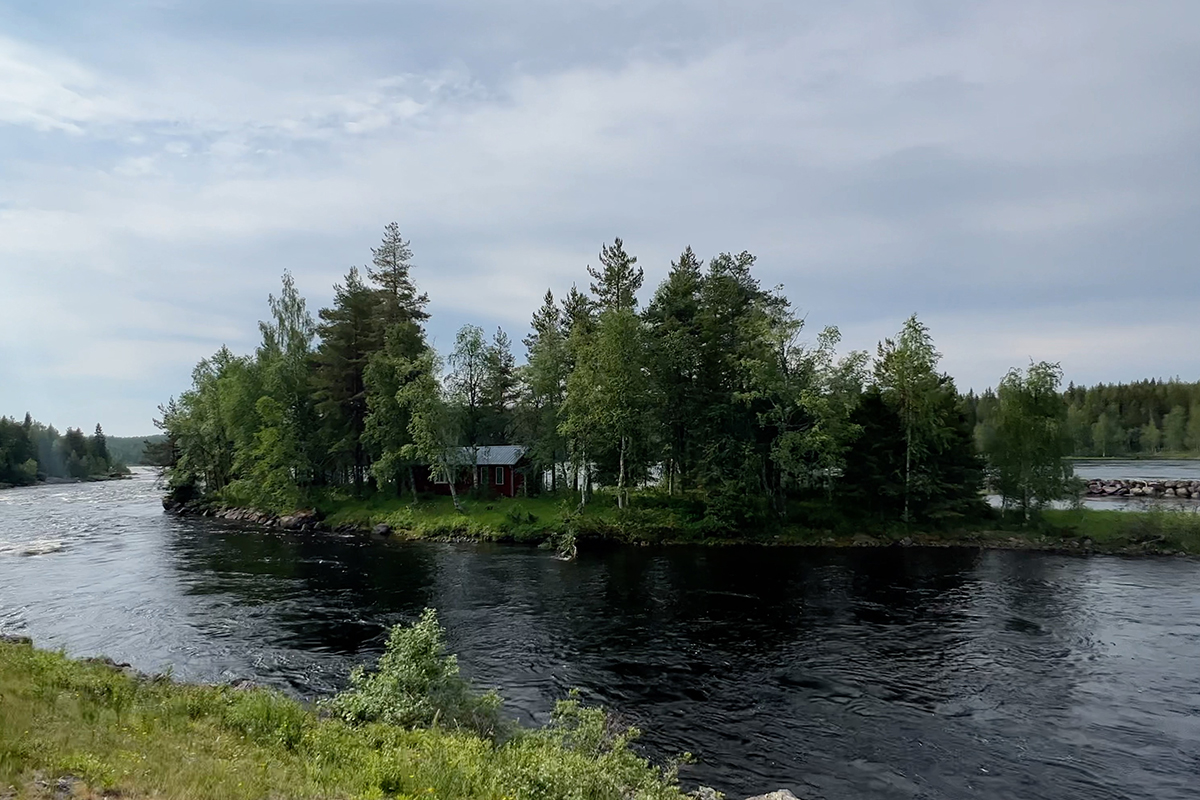
The checkpoint was situated down by one of the many rapids of the Vindel River. Sitting by the campfire chatting with Johnny and his wife Annette I ate a grilled hot dog, a sandwich, a cinnamon bun and an apple, and then I was off again to Åmsele.
Having not had taken a proper rest since Mo i Rana I decided to take a nap at the checkpoint at Åmsele camping. Here, Margaretha was servering the now famous fried palt with melted butter and lingonberries. And so after a second helping of palt I definitely felt it was time for a nap. Clouds were gathering and the first rain now started to fall. Whilst taking my nap Tom, Tomas, and Björn, a group of local riders together with Andy from the UK, arrived at Åmsele camping and we later left together on the final stage to Umeå.
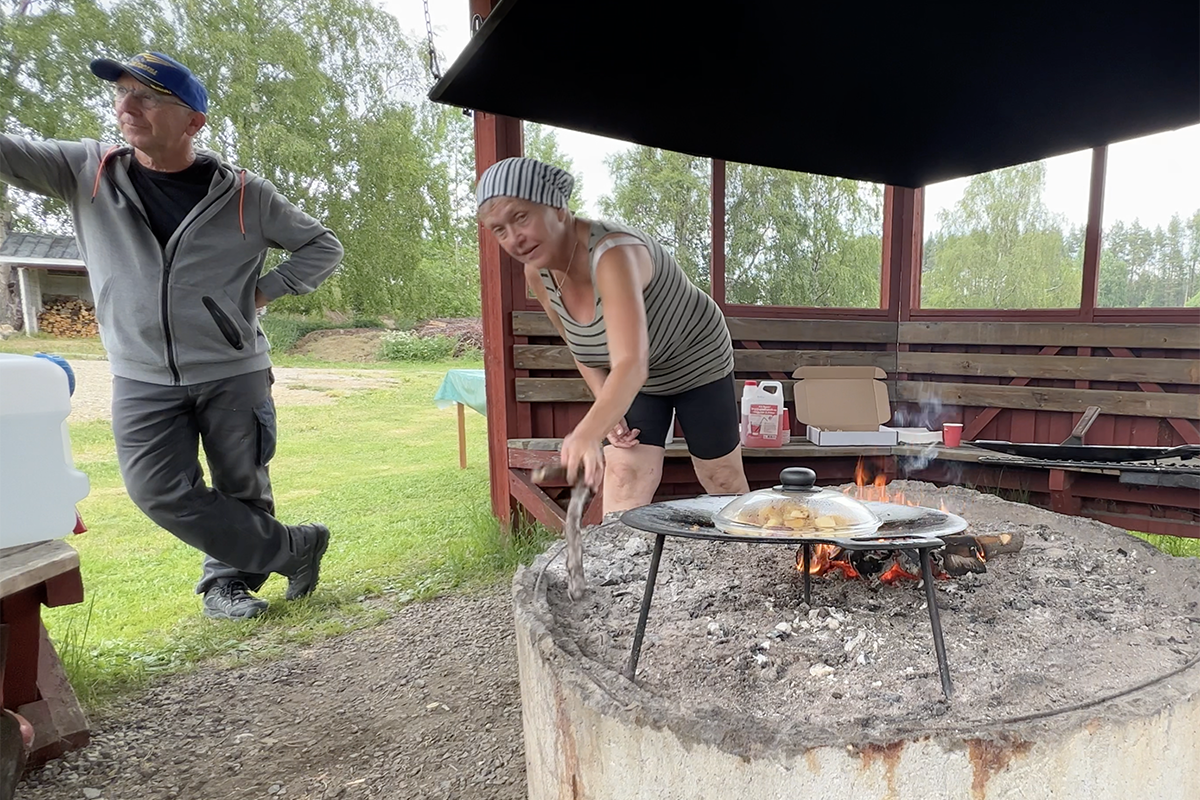
Åmsele – Umeå
On the final stage a long the Vindel River the rain showers were at times fairly heavy but it was a reasonably warm rain so we pressed on.
We arrived to the Umeå Plaza in the evening and with minutes left before the hotel bar closed we ordered a beer to celebrate our arrival back to Umeå, and ate our cake: ”Soleil de Minuit”.

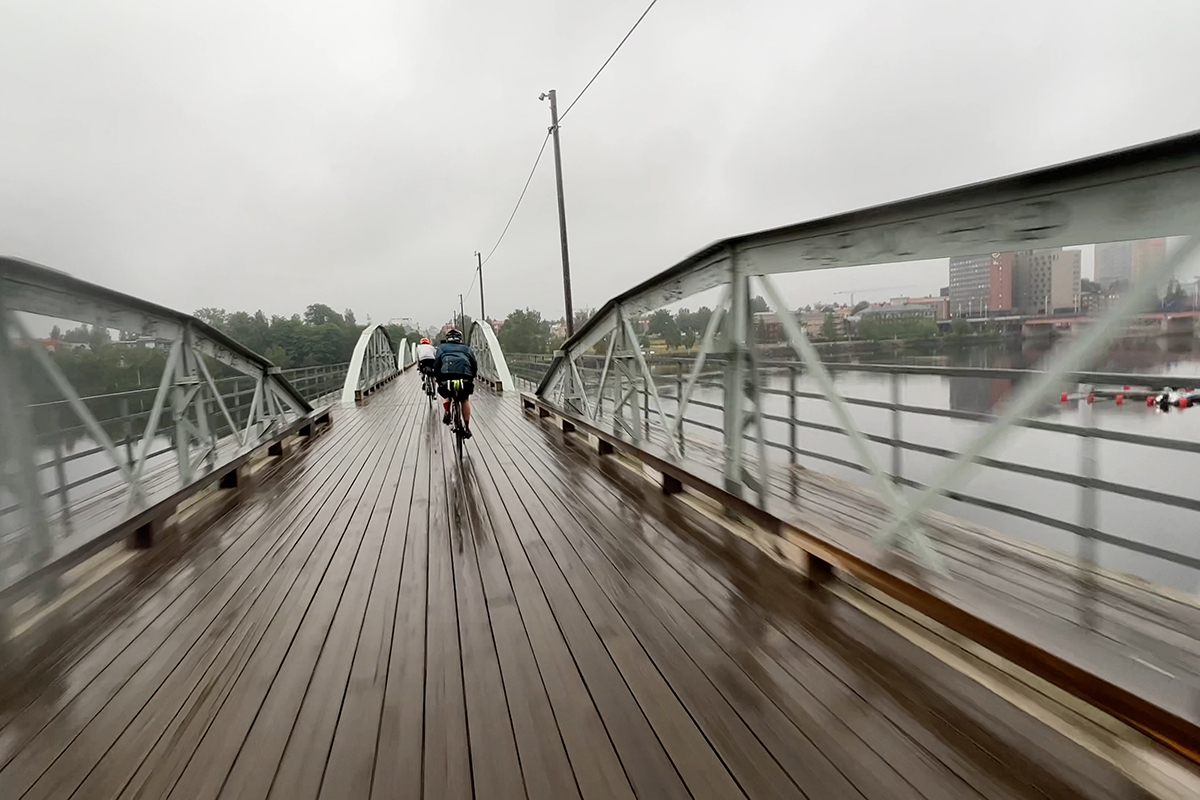
Arto Sundström
Preparations
Spring came late and there was little cycling before the MRS brevet. I rode 2 x 200 km and 2 x 300 km. Before the event, I was unsure about my cycling condition. Departure time for the event was in the evening at 23:07 on Monday, in Umeå. In the evening, before leaving, it was better to have a good rest, but I couldn’t sleep at all. My lovely wife Leila, who followed me on this trip, stayed in our caravan in the parking location. There was no electricity in the parking lot, but fortunately, we have our own generators to use while she waits for my return.
Umeå – Hattfjelldal (451 km)
The departure took place briskly, pedaling as is usual in these events. The first crash happened already 35 km after the start. The Finnish girl crashed the bike and the rear derailleur broke. She and her husband had to go back. I rode in a group that included a Swedish ”Hero” (I don’t remember the name) who was on the same brevet with me and Mikko Mäkipää on the silk road, both with a Norwegian woman and with Marko and Mikaela (the Finnish couple who were last year in the same event). The check-out points were quickly passed one after the other while the weather was calm. The route had changed at the beginning due to roadworks. A last-minute change was going to cause problems, but luckily I was able to download the new route on my navigator.
Storuman’s control became unpredictable (231km) average speed had been a staggering 27 km/h for me. After Storuman, the first hills begin. There was a feeling of rain in the air, but luckily it didn’t rain and the weather was cloudy. The group had already broken up before Storuman, only a group of Spanish followed us. Before the control of Kittelfjellet, there is a 20 km stretch of gravel road, the first 10 km of it was in really bad condition. There was a possibility to have a flat tire, but luckily I survived only with the chains coming off. According to Marko, the same gravel road last year took twice the time. I arrived at Kittelfjellet 352 km at 16:00, and Marko arrived there at 21:00 Last year MRS Brevet. Kittefjellet had the best food served by the organizer. A really big portion of pasta carbonara. From Kittefjellet, the actual cluster of climbs begins, which continues until Vuoggatjålme, 736 km. Hattfjelldal Road is a little uphill and downhill. The road follows the river, but the height differences are commendable. There was no traffic so I could drive alone listening to music and sometimes getting wet, thanks to the thunderstorm. I arrived at Hattefjellet at 21:15 and decided to take the Singel room, which was a good decision. I heard that others in shared accommodation were not able to sleep. I slept well and could sleep effectively between 10:00 PM to 3:00 AM. I slept like a little baby.
Hattfjelldal – Vuoggatjålme (283 Km)
I started the next day happy and relatively rested. Right at the beginning of Hattfjelldal, there is a really huge hill that takes you to the top of the mountain. That really got my legs warmed up. The scenery was beautiful and there was little traffic. Mo i Rana came as a surprise because the control was about 15 km before the city. I continued the journey mostly alone, but Marko and Mikaela were almost there. The route went along the E6 towards the Arctic Circle. Fredrik, a Belgeum-Swedish man, with a beard and funny, had left his phone in Mo i Rana and was able to arrange for the phone to be transported there.
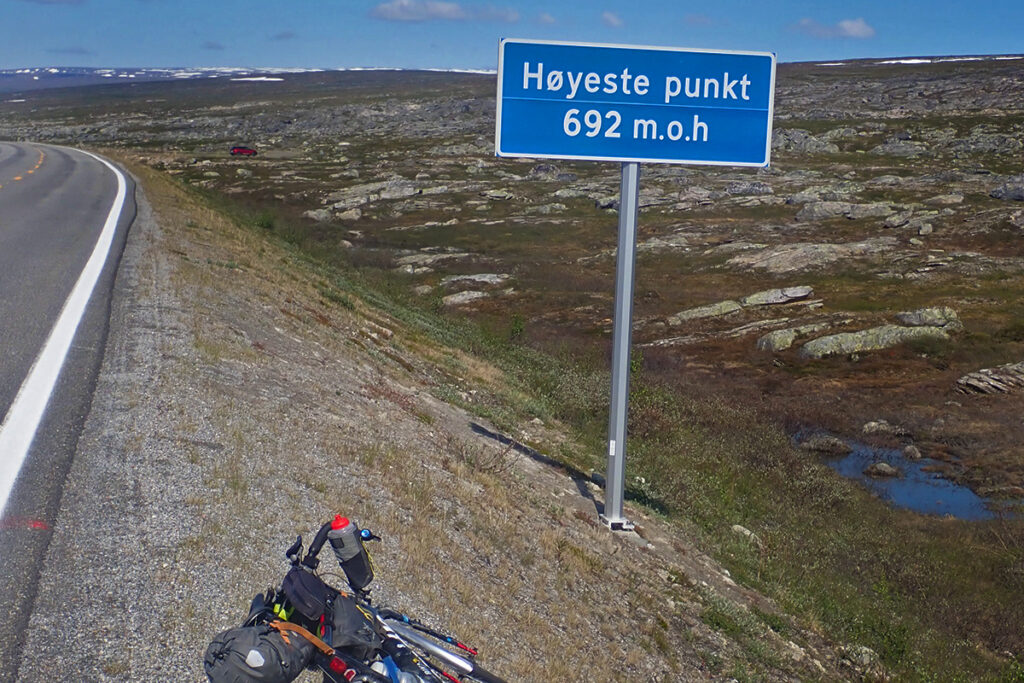
After the Arctic Circle, there is an almost 23 km fast downhill section, followed by the most demanding climb of the route. It is a detour to the tunnel including a 12% elevation climbing for 3 km. During that climb, the sun got so hot that a member of the ”tomato” group (A Finnish group from Vaasa in tomato design shirts) had a heat stroke. The scenery was amazing and the trip progressed at a really easy uphill pace for me. I arrive in Vuogattjålme at 21:15 at night.

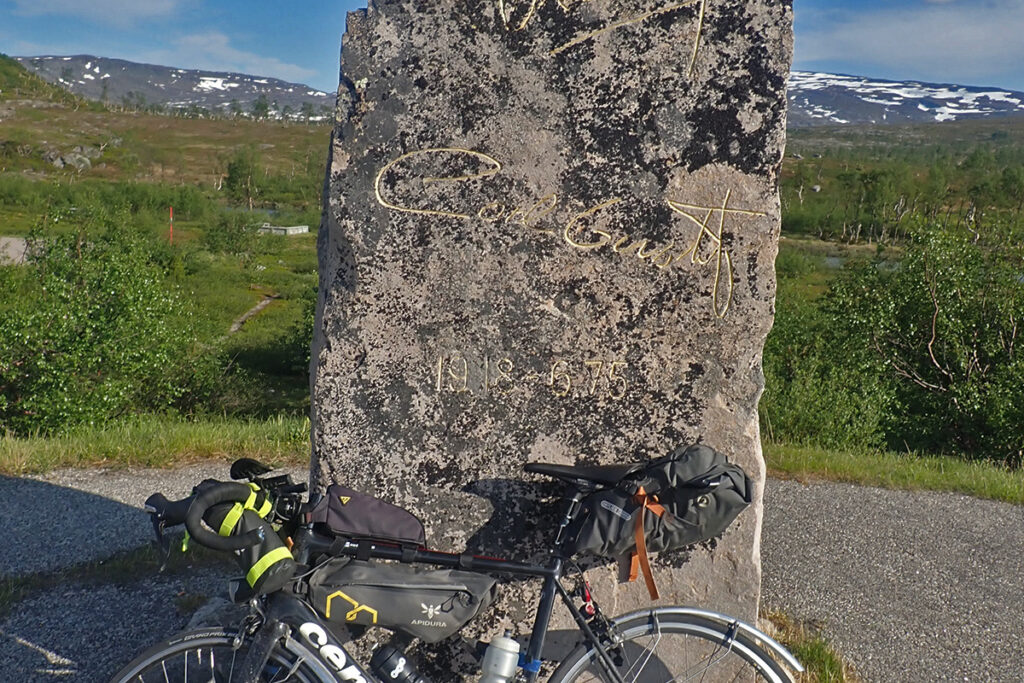
The organiser had reserved a few cabins in the area for accommodation. I tried to eat the offered macaroni salad, but nothing came of eating when I dropped the whole portion on the ground. I reserved my own room in the cabin by wearing a randonneurs shirt as a sign of the reservation. Nothing came of sleeping this time. Maybe over tiredness, heat, or noise. However, I persisted in bed until 03:00. Marko and Mikaela had the same problem and had already started driving at 23:00 toward the next control. I heard that they had tried to sleep in foil during the trip with little success.
Vuoggatjålme – Umeå (470 km)
The road is mainly downhill to the next control Arjeplog 841 km. The trip went well with the forest rabbits competing with me on the road. I admire the wonderful mountain scenery. The Arjeplog control hotel is a wonderful building full of old history. If I participate in the next MSR, it is definitely worth booking accommodation at that place.

The ”tomato” group had slept there, they had received good free accommodation from the ”conference” facilities. Fredrik had found the phone and had also come part of the way with me for a check-up. However, I went ahead alone. I reached Fredrik on the way and we drove together until 932 km to Sorsele. In Sorsele, the organizer provided meat food and apple juice, which I found really tasty, they were like bird’s milk. After Sorsele, I caught up with Fredrik again and we drove together. The ”Tomato” group reached us and asked us to join.
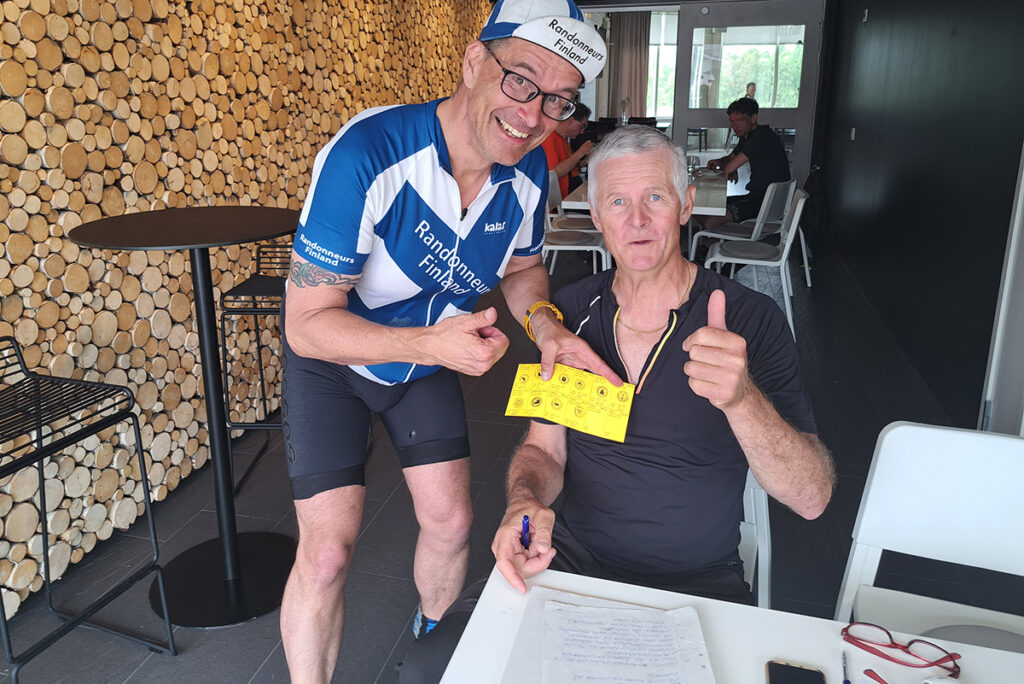
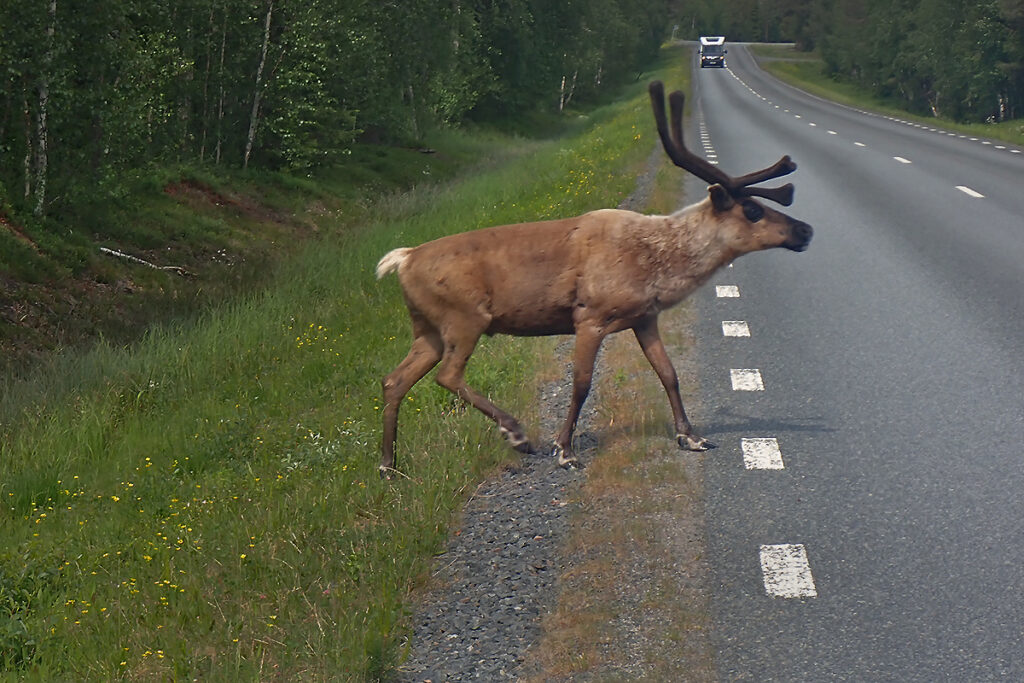
I then rode with them the rest of the way to the finish line. The Tomato group they have had no previous experience in Brevet cycling. Their navigator was broken and they have to follow me and Fredrick. They marveled at the operation of the pole dynamo and listened admiringly to stories about Ruska’s travels. The speed was commendable with these old machines. I even felt younger. The infamous Åmsele 1089 Km (Valjakkala murders 1988) was completed at 22:00.
The last 125 km were left. Fredrik stayed there to sleep, but I and the tomatoes drove all the way to Umeå with the downwind through the downhill. I received excellent praise after guiding the group to Scandic Hotel in Umeå. I ended the Brevet happily which was one of the toughest in my history, with 11 1104 m elevation. The course was well organised and nature left me with a remarkable touch and I will DEFINITELY join next year.
End time: 76 hours
Accommodation: Hattfjelldal, Vuoggatjålme
Night sleep: 2 x 5 hours of which 5 hours are ”dog sleep”
Condition of the bike: the chains came off once and the chain grease once
Equipment: Summer driving shirt and winter driving jacket with Merino sweater
Gloves: merino wool gloves and summer mittens
Drinking bottles: three, of which usually only two were needed on a stage
Food: well available on behalf of the organisers
The event left a good impression, which may also be due to the excellent weather. The arrangements were top class and the staff cheerful and nice. Thank you for a really great event.
RUSKA no.11
ARTO Sundström, Finland
